Advanced Energy Performance Modelling: Case Study of an Engineering and Technology Precinct
Abstract
1. Introduction
1.1. Background
1.2. Problem Definition
1.3. Research Objectives
2. Literature Review
2.1. Building Energy Simulation
2.2. Utilizing Regression Models for Enhanced Energy Simulation
2.3. Application of Building Information Modeling (BIM) in Energy Simulation
2.4. Former Case Studies
2.4.1. Abercrombie Business School (ABS)
2.4.2. Tyree Building (UNSW)
2.4.3. Summary of Case Studies
2.5. Elevating Building Energy Management and Optimization Systems via the Implementation of Digital Twin (DT) Technology
3. Methodology
3.1. BIM-Based Modelling
3.1.1. Building Geometry Model
- Construct a Virtual Geometric Model: Develop an intricate virtual geometric model that accurately represents the architectural structure.
- Formulate a Building Energy Model: To emulate the building’s energy dynamics and consumption patterns.
- Perform Energy Analysis via Software: Engage dedicated software tools to conduct an in-depth energy analysis of the building.
- Apply Python for Energy Analysis Algorithms: Use Python to create and implement sophisticated energy analysis algorithms.
- Assess Algorithm Performance: Investigate and evaluate the efficacy of the deployed energy analysis algorithms.
- Integrate Real-Time Monitoring Sensors: Embed sensors to provide continuous real-time data, enhancing the building’s energy performance analysis.
3.1.2. Building Energy Model
3.2. Energy Simulation in OpenStudio Using EnergyPlus
3.2.1. Simulation Parameter Settings
- Space type designation was standardized using the ‘Default file 189.1-2009—office—closed office’.
- The simulation adhered to the schedule defined by the ‘Default file 189.1-2009—office—closed office’.
- Building construction parameters were aligned with the ‘Default file 189.1-2009-CZ1-office’.
- Climate data was sourced from the Sydney area weather file on the EnergyPlus official website.
3.2.2. Simulation Result Data Processing
3.3. Regression Analysis
3.4. Implementing Sensors for Real-Time Simulation
- Setting up Modbus Communication: Configuring serial parameters and initializing an object.
- Creating a CSV File: Opening a new file with headers for timestamp and temperature.
- Real-Time Data Logging: Continuously read and log temperature and time, displaying them in real time.
- Error Handling: Managing reading errors by displaying messages and continuing data collection.
3.5. DTFramework Model under the J03 Case Study
3.5.1. Assumed Efficiency Coefficients & Adaptive Factor Adjustments
3.5.2. Adaptive Factor Adjustments
Window Ventilation
Dimming Light Intensity
3.5.3. Simulation of Building Optimization System Based on Real-Time Temperature
- These are average values for the entire building, based on the standard area (68.19 m2) determined by Energy Plus results.
- The annual optimal electricity consumption standard for the region is 5200 kWh (calculated based on 260 days multiplied by 8 h per day), which can be adjusted as needed.
- The temperature data comes from the J03 building of the University of Sydney on October 8 and is assumed to be the real-time temperature within the system.
4. Results
4.1. Processed Energy Simulation Results from EnergyPlus
4.2. Linear Regression Analysis
4.3. Sigmoid Model with Transformed Xs
4.4. Random Forest Regression Model
4.5. Regression Models Comparison
4.6. DTModels
5. Discussion
5.1. Significance and Limitation
5.2. Comparison of the Regression Models
5.3. Simulated Adaptive System Limitations
5.4. Implications of Energy Efficiency and Management
5.5. Future Direction
5.5.1. Based on Environmental Changes
5.5.2. Based on Occupancy Monitoring
5.5.3. Zone by Zone Control: Enhancing Building Energy Efficiency
6. Conclusions
Author Contributions
Funding
Data Availability Statement
Acknowledgments
Conflicts of Interest
Appendix A
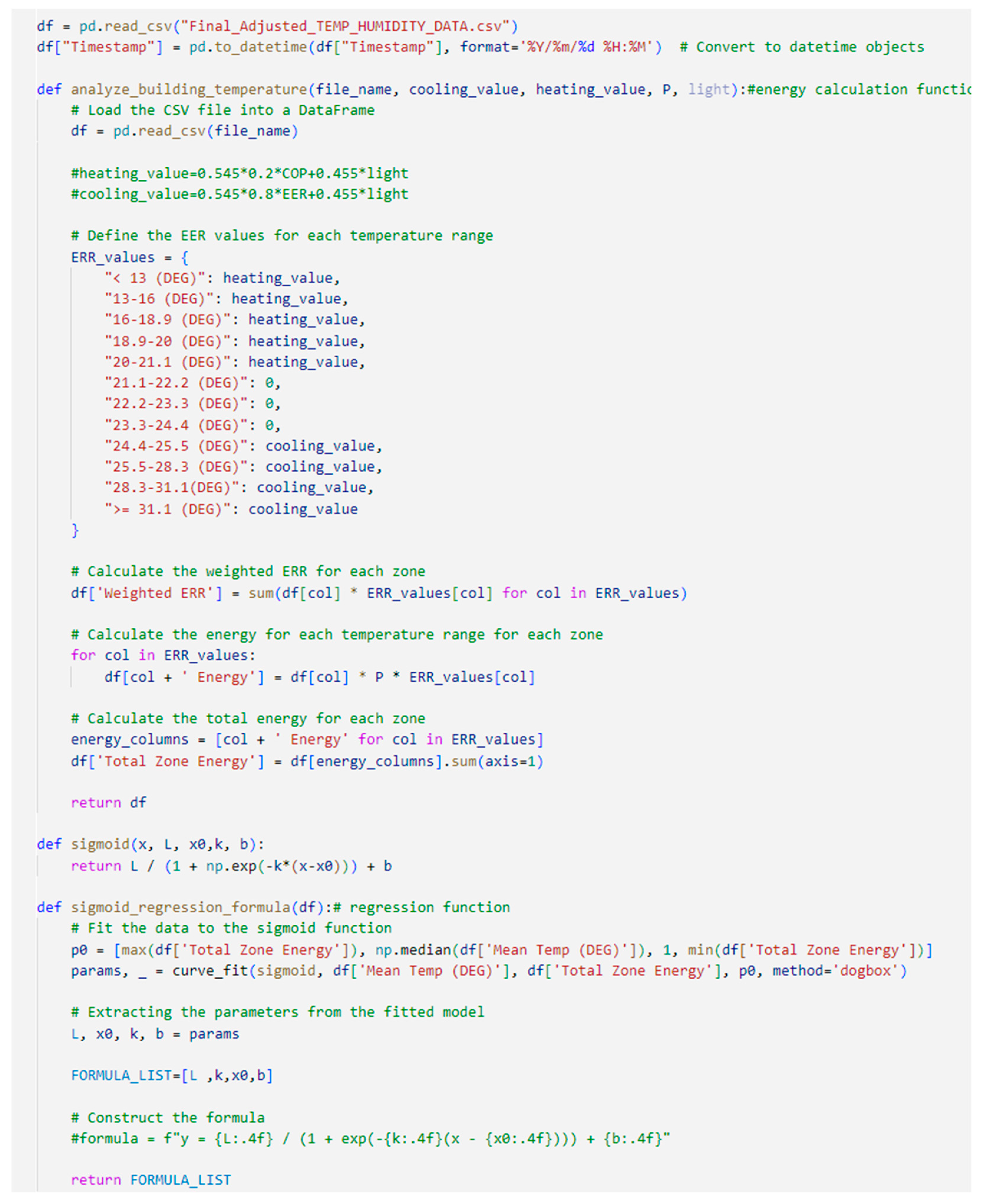


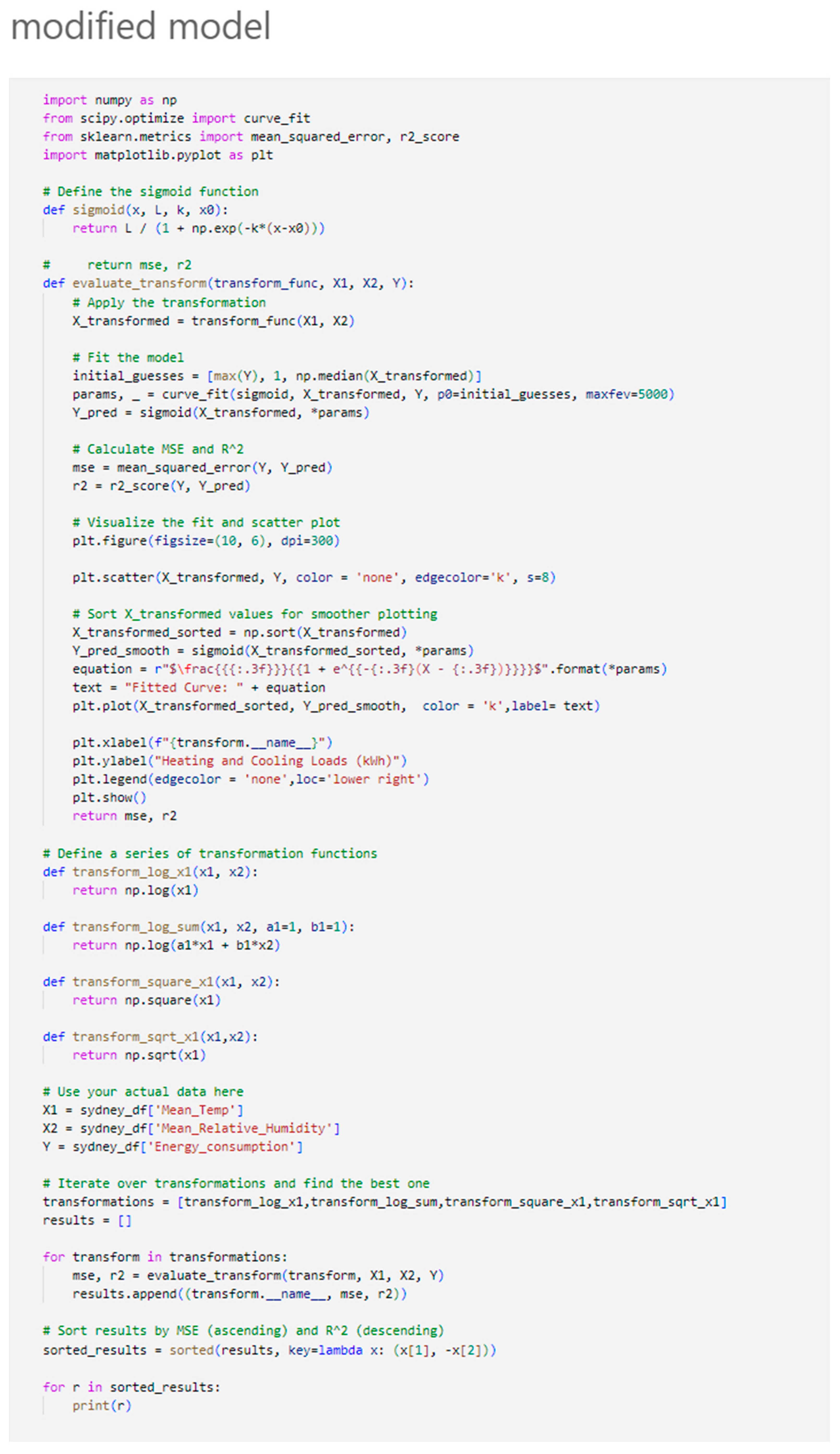

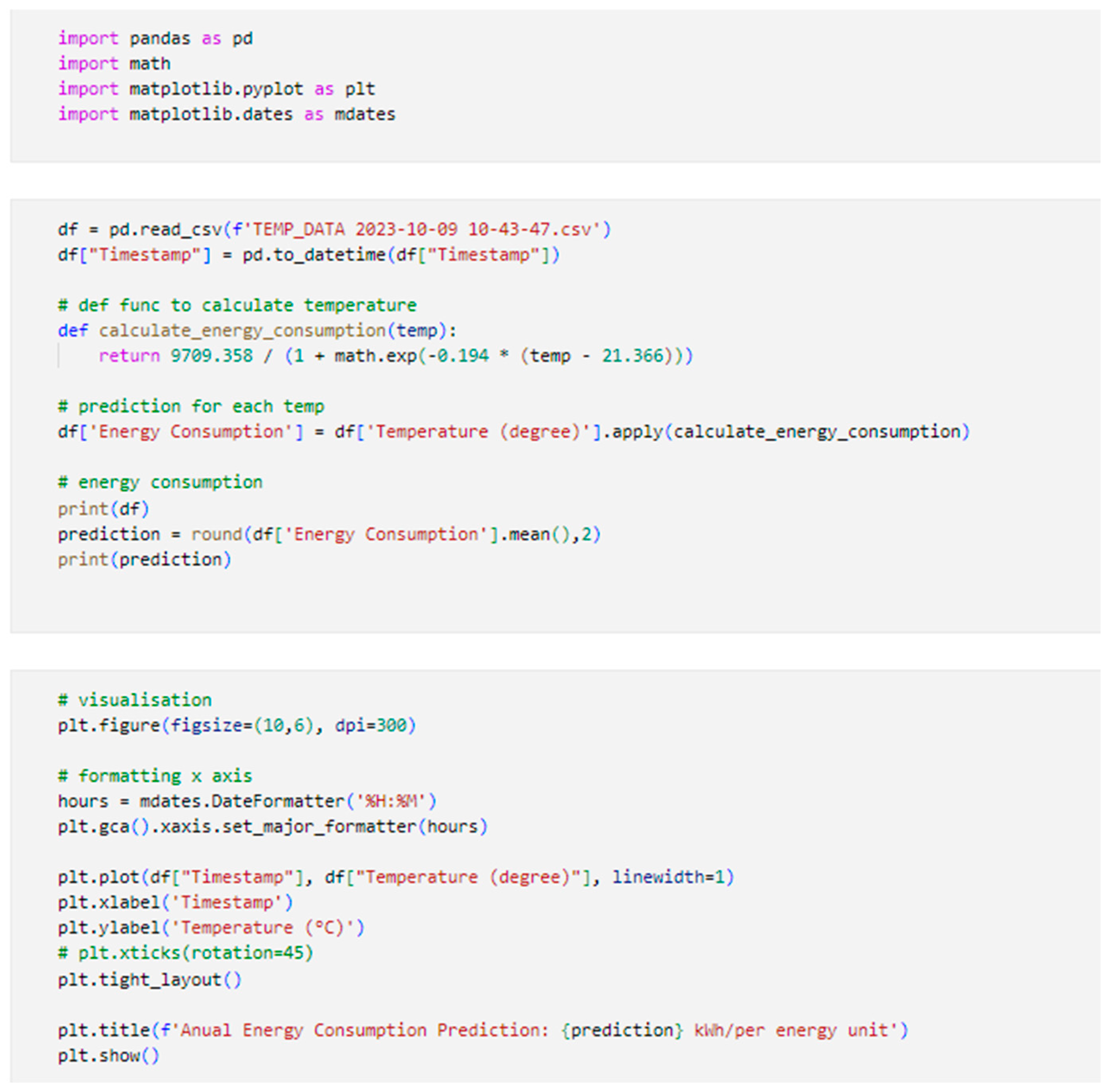
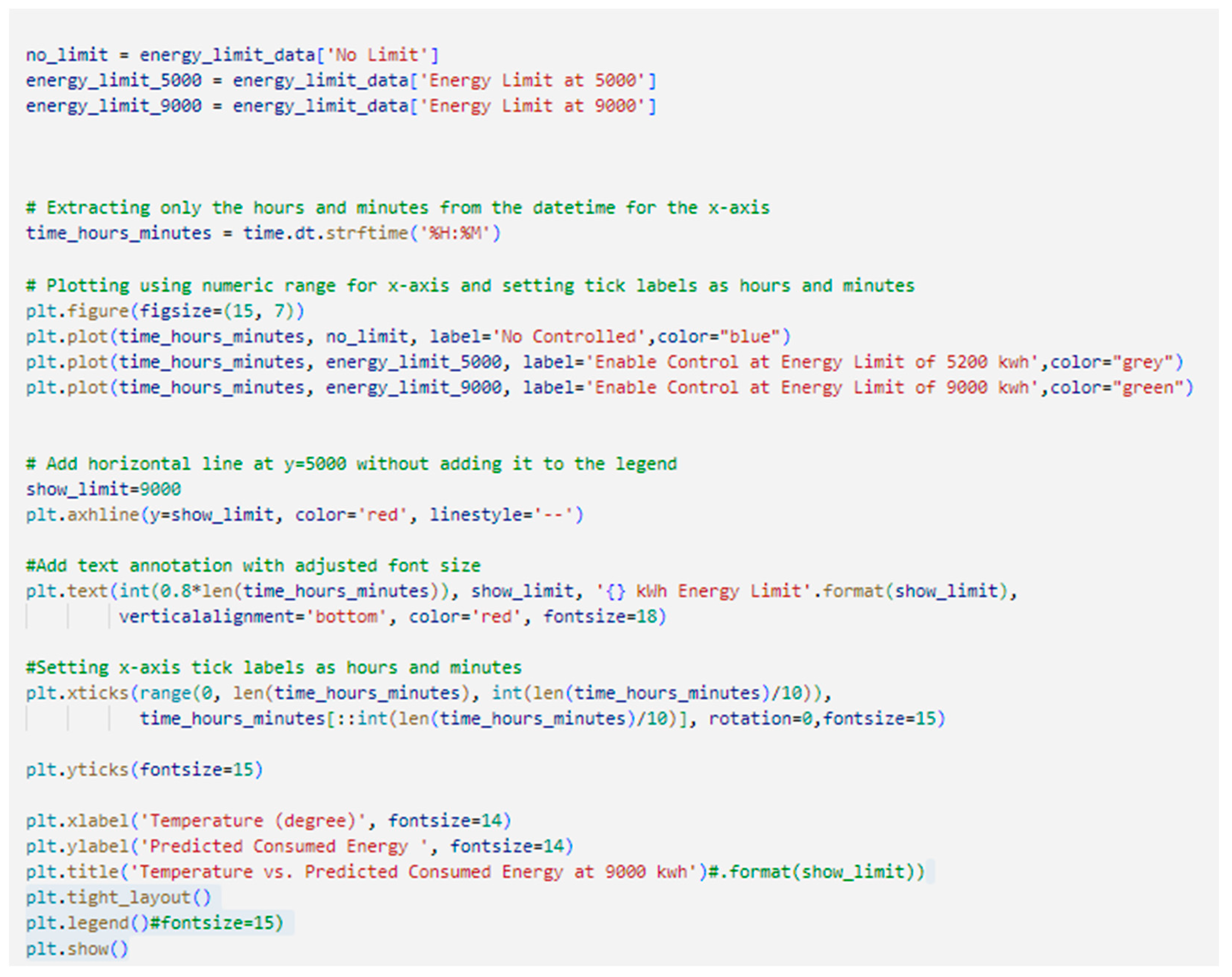
References
- Lu, C.; Li, S.; Lu, Z. Building energy prediction using artificial neural networks: A literature survey. Energy Build. 2022, 262, 111718. [Google Scholar] [CrossRef]
- GhaffarianHoseini, A.; Dahlan, N.D.; Berardi, U.; GhaffarianHoseini, A.; Makaremi, N.; GhaffarianHoseini, M. Sustainable energy performances of green buildings: A review of current theories, implementations and challenges. Renew. Sustain. Energy Rev. 2013, 25, 1–17. [Google Scholar] [CrossRef]
- Kumaraswamy, M.M.; Hewa Welege, N.M.; Pan, W. Accelerating the delivery of low-carbon buildings by addressing common constraints: Perspectives from high-rise, high-density cities. Buildings 2023, 13, 1455. [Google Scholar] [CrossRef]
- Pan, Y.; Zhu, M.; Lv, Y.; Yang, Y.; Liang, Y.; Yin, R.; Yang, Y.; Jia, X.; Wang, X.; Zeng, F.; et al. Building energy simulation and its application for building performance optimization: A review of methods, tools, and case studies. Adv. Appl. Energy 2023, 10, 100135. [Google Scholar] [CrossRef]
- Liu, Z.; Zhang, X.; Sun, Y.; Zhou, Y. Advanced controls on energy reliability, flexibility and occupant-centric control for smart and energy-efficient buildings. Energy Build. 2023, 297, 113436. [Google Scholar] [CrossRef]
- Zhou, P.; Lv, Y.; Wen, W. The low-carbon transition of energy systems: A bibliometric review from an engineering management perspective. Engineering 2023, 29, 147–158. [Google Scholar] [CrossRef]
- Jafari, M.; Kavousi-Fard, A.; Chen, T.; Karimi, M. A review on digital twin technology in smart grid, transportation system and smart city: Challenges and future. IEEE Access 2023, 11, 17471–17484. [Google Scholar] [CrossRef]
- Nguyen, T.D.; Adhikari, S. The role of bim in integrating digital twin in building construction: A literature review. Sustainability 2023, 15, 10462. [Google Scholar] [CrossRef]
- Sepasgozar, S.M.E.; Khan, A.A.; Smith, K.; Romero, J.G.; Shen, X.; Shirowzhan, S.; Li, H.; Tahmasebinia, F. Bim and digital twin for developing convergence technologies as future of digital construction. Buildings 2023, 13, 441. [Google Scholar] [CrossRef]
- Pan, Y.; Zhang, L. Integrating bim and ai for smart construction management: Current status and future directions. Arch. Comput. Methods Eng. 2023, 30, 1081–1110. [Google Scholar] [CrossRef]
- Rahman, H.; Shah, U.M.; Riaz, S.M.; Kifayat, K.; Moqurrab, S.A.; Yoo, J. Digital twin framework for smart greenhouse management using next-gen mobile networks and machine learning. Future Gener. Comput. Syst. 2024, 156, 285–300. [Google Scholar] [CrossRef]
- Phillip, D.; Chen, J.; Maksakuli, F.; Ruci, A.; Sturdivant, E.e.; Zhu, Z. Improving Building Energy Efficiency through Data Analysis; Association for Computing Machinery: New York, NY, USA, 2023. [Google Scholar]
- Kineber, A.F.; Singh, A.K.; Fazeli, A.; Mohandes, S.R.; Cheung, C.; Arashpour, M.; Ejohwomu, O.; Zayed, T. Modelling the relationship between digital twins implementation barriers and sustainability pillars: Insights from building and construction sector. Sustain. Cities Soc. 2023, 99, 104930. [Google Scholar] [CrossRef]
- de Moura Scortegagna, E.; Martins, N.; Lamberts, R. Can we trust building energy performance models’ results? In Proceedings of the 18th International IBPSA Building Simulation, Shanghai, China, 4–6 September 2023. [Google Scholar]
- Bâra, A.; Oprea, S. Enabling coordination in energy communities: A Digital Twin model. Energy Policy 2023, 184, 1–21. [Google Scholar] [CrossRef]
- Kaghembega, W.S.-H.; Chen, S.; Tchewafei, A.; Jiang, K.; Yingying, L. Evaluation of environmental impact and GHG emission with energy system modeling combined with LCA in building sector: A review. E3S Web Conf. 2023, 433, 02001. [Google Scholar] [CrossRef]
- Shirowzhan, S.; Sepasgozar, S.M.E.; Edwards, D.J.; Li, H.; Wang, C. BIM compatibility and its differentiation with interoperability challenges as an innovation factor. Autom. Constr. 2020, 112, 103086. [Google Scholar] [CrossRef]
- Durdyev, S.; Dehdasht, G.; Mohandes, S.R.; Edwards, D.J. Review of the building information modelling (Bim) implementation in the context of building energy assessment. Energies 2021, 14, 8487. [Google Scholar] [CrossRef]
- Khasreen, M.M.; Banfill, P.F.G.; Menzies, G.F. Life-cycle assessment and the environmental impact of buildings: A review. Sustainability 2009, 1, 674–701. [Google Scholar] [CrossRef]
- Hilpert, S.; Kaldemeyer, C.; Krien, U.; Günther, S.; Wingenbach, C.; Plessmann, G. The Open Energy Modelling Framework (Oemof)—A new approach to facilitate open science in energy system modelling. Energy Strategy Rev. 2018, 22, 16–25. [Google Scholar] [CrossRef]
- Pfenninger, S.; Hawkes, A.; Keirstead, J. Energy systems modeling for twenty-first century energy challenges. Renew. Sustain. Energy Rev. 2014, 33, 74–86. [Google Scholar] [CrossRef]
- Asadi, S.; Amiri, S.S.; Mottahedi, M. On the development of multi-linear regression analysis to assess energy consumption in the early stages of building design. Energy Build. 2014, 85, 246–255. [Google Scholar] [CrossRef]
- Olu-Ajayi, R.; Alaka, H.; Owolabi, H.; Akanbi, L.; Ganiyu, S. Data-driven tools for building energy consumption prediction: A review. Energies 2023, 16, 2574. [Google Scholar] [CrossRef]
- Liu, C.; Zhang, P.; Xu, X. Literature review of digital twin technologies for civil infrastructure. J. Infrastruct. Intell. Resil. 2023, 2, 100050. [Google Scholar] [CrossRef]
- Liu, X.; Ding, Z.; Li, X.; Xue, Z. Research progress, hotspots, and trends of using bim to reduce building energy consumption: Visual analysis based on wos database. Int. J. Environ. Res. Public Health 2023, 20, 3083. [Google Scholar] [CrossRef]
- Gupta, R.; Mathur, J.; Garg, V. Assessment of climate classification methodologies used in building energy efficiency sector. Energy Build. 2023, 298, 113549. [Google Scholar] [CrossRef]
- Anand, A.; Deb, C. The potential of remote sensing and GIS in urban building energy modelling. Energy Built Environ. 2023, 5, 957–969. [Google Scholar] [CrossRef]
- Li, F.; Wan, Z.; Koch, T.; Zan, G.; Li, M.; Zheng, Z.; Liang, B. Improving the accuracy of multi-step prediction of building energy consumption based on EEMD-PSO-Informer and long-time series. Comput. Electr. Eng. 2023, 110, 108845. [Google Scholar] [CrossRef]
- Tahmasebinia, F.; Lin, L.; Wu, S.; Kang, Y.; Sepasgozar, S. Exploring the benefits and limitations of digital twin technology in building energy. Appl. Sci. 2023, 13, 8814. [Google Scholar] [CrossRef]
- Breiman, L. Random forests. Mach. Learn. 2001, 45, 5–32. [Google Scholar] [CrossRef]
- Oviedo De Valeria, J. Problemas de máximos y mínimos y algunas reflexiones sobre el automatismo en su resolución. Educación matemática 1994, 6, 73–86. Available online: http://www.revista-educacion-matematica.org.mx/descargas/vol6/vol6-2/vol6-2-5.pdf (accessed on 6 May 2024). [CrossRef]
- Artificial Neural Network—An Overview|Sciencedirect Topics. Available online: https://www.sciencedirect.com/topics/neuroscience/artificial-neural-network#:~:text=Artificial%20Neural%20Network%20(ANN)%20mimics,is%20obtained%20as%20an%20output (accessed on 6 May 2024).
- Pawan, S.J.; Rajan, J. Capsule networks for image classification: A review. Neurocomputing 2022, 509, 102–120. [Google Scholar] [CrossRef]
- Tekler, Z.D.; Low, R.; Zhou, Y.; Yuen, C.; Blessing, L.; Spanos, C. Near-real-time plug load identification using low-frequency power data in office spaces: Experiments and applications. Appl. Energy 2020, 275, 115391. [Google Scholar] [CrossRef]
- Al Gharably, M.; DeCarolis, J.F.; Ranjithan, S.R. An enhanced linear regression-based building energy model (Lrbem+) for early design. J. Build. Perform. Simul. 2016, 9, 115–133. [Google Scholar] [CrossRef]
- Ciulla, G.; D’Amico, A. Building energy performance forecasting: A multiple linear regression approach. Appl. Energy 2019, 253, 113500. [Google Scholar] [CrossRef]
- Begić, H.; Galić, M. A systematic review of construction 4.0 in the context of the bim 4.0 premise. Buildings 2021, 11, 337. [Google Scholar] [CrossRef]
- Schwab, K. The Fourth Industrial Revolution; Currency Press: Sydney, Australia, 2017; p. 194. [Google Scholar]
- Low-Energy Building Design—The Process and a Case Study—ProQuest. Available online: https://www.proquest.com/openview/330c19f6ef3f0b358d2373fa1ab8a56c/1?pq-origsite=gscholar&cbl=34619 (accessed on 6 May 2024).
- Chen, S.; Jin, R.; Alam, M. Investigation of interoperability between building information modelling (Bim) and building energy simulation (Bes). Int. Rev. Appl. Sci. Eng. 2018, 9, 137–144. [Google Scholar] [CrossRef]
- Pereira, V.; Santos, J.; Leite, F.; Escórcio, P. Using BIM to improve building energy efficiency—A scientometric and systematic review. Energy Build. 2021, 250, 111292. [Google Scholar] [CrossRef]
- Tahmasebinia, F.; Jiang, R.; Sepasgozar, S.; Wei, J.; Ding, Y.; Ma, H. Using regression model to develop green building energy simulation by bim tools. Sustainability 2022, 14, 6262. [Google Scholar] [CrossRef]
- Tahmasebinia, F.; He, R.; Chen, J.; Wang, S.; Sepasgozar, S.M.E. Building energy performance modeling through regression analysis: A case of tyree energy technologies building at unsw sydney. Buildings 2023, 13, 1089. [Google Scholar] [CrossRef]
- Lu, Q.; Xie, X.; Parlikad, A.K.; Schooling, J.M.; Konstantinou, E. Moving from building information models to digital twins for operation and maintenance. Proc. Inst. Civ. Eng.—Smart Infrastruct. Constr. 2021, 174, 46–56. [Google Scholar] [CrossRef]
- Callcut, M.; Cerceau Agliozzo, J.-P.; Varga, L.; McMillan, L. Digital twins in civil infrastructure systems. Sustainability 2021, 13, 11549. [Google Scholar] [CrossRef]
- Spudys, P.; Afxentiou, N.; Georgali, P.-Z.; Klumbyte, E.; Jurelionis, A.; Fokaides, P. Classifying the operational energy performance of buildings with the use of digital twins. Energy Build. 2023, 290, 113106. [Google Scholar] [CrossRef]
- Seo, H.; Yun, W.-S. Digital twin-based assessment framework for energy savings in university classroom lighting. Buildings 2022, 12, 544. [Google Scholar] [CrossRef]
- Francisco, A.; Mohammadi, N.; Taylor, J.E. Smart city digital twin–enabled energy management: Toward real-time urban building energy benchmarking. J. Manag. Eng. 2020, 36, 04019045. [Google Scholar] [CrossRef]
- Autodesk. 2022. Revit. [Software]. Version 22.1.30.34. Available online: http://www.autodesk.com/products/revit/overview (accessed on 6 May 2024).
- Guglielmetti, R.; Macumber, D.; Long, N. Openstudio: An Open Source Integrated Analysis Platform; National Renewable Energy Lab (NREL): Golden, CO, USA, 2011. [Google Scholar]
- Energyplus™; National Renewable Energy Laboratory (NREL): Golden, CO, USA; Lawrence Berkeley National Laboratory (LBNL): Berkeley, CA, USA, 2017.
- Python Software Foundation. Python. [Software] Version 3.10.11. 2023. Available online: https://www.python.org/downloads/release/python-31011/ (accessed on 6 May 2024).
- AS/NZS ISO 5151:2023; Non-Ducted Air Conditioners and Heat Pumps—Testing and Rating for Performance. Standards Australia Store: Sydney, Australia, 2023.
- Pérez-Lombard, L.; Ortiz, J.; Maestre, I.R.; Coronel, J.F. Constructing HVAC energy efficiency indicators. Energy Build. 2012, 47, 619–629. [Google Scholar] [CrossRef]
- Liao, S.-B.; Walker, J.; Halliday, D.; Resnick, R. Student Solutions Manual to Accompany Fundamentals of Physics, 10th ed.; Halliday, D., Resnick, R., Walker, J., Eds.; John Wiley & Sons: Hoboken, NJ, USA, 2014; p. 509. [Google Scholar]
- ISO. Guide to the Expression of Uncertainty in Measurement; ISO: Geneva, Switzerland, 2008. [Google Scholar]
- Monteiro, S.; Monteiro, F.P.; Tostes, M.E.L.; Carvalho, C.M. Methodology for Energy Efficiency on Lighting and Air Conditioning Systems in Buildings Using a Multi-Objective Optimization Algorithm. Energies 2020, 13, 3303. [Google Scholar] [CrossRef]
- Energyplus. Energy.gov. Available online: https://www.energy.gov/ (accessed on 6 May 2024).
- Nouidui, T.; Wetter, M.; Zuo, W. Functional mock-up unit for co-simulation import in EnergyPlus. J. Build. Perform. Simul. 2014, 7, 192–202. [Google Scholar] [CrossRef]
- Chapter 2—Policies, recommendations and standards (International technical standards, main laws and regulations; eu directives; energy labeling). In Handbook of Energy Efficiency in Buildings; Asdrubali, F., Desideri, U., Eds.; Butterworth-Heinemann: Oxford, UK, 2019; pp. 5–73. [Google Scholar]
- McFadden, D. Conditional logit analysis of qualitative choice behavior. In Frontiers in Econometrics; Academic Press: New York, NY, USA, 1974; pp. 105–142. [Google Scholar]
- Hauer, M.; Hammes, S.; Zech, P.; Geisler-Moroder, D.; Plörer, D.; Miller, J.; van Karsbergen, V.; Pfluger, R. Integrating Digital Twins with BIM for Enhanced Building Control Strategies: A Systematic Literature Review Focusing on Daylight and Artificial Lighting Systems. Buildings 2024, 14, 805. [Google Scholar] [CrossRef]
- Zhao, J.; Lam, K.P.; Ydstie, B.E.; Karaguzel, O.T. EnergyPlus Model-Based Predictive Control within Design–Build–Operate Energy Information Modelling Infrastructure. J. Build. Perform. Simul. 2015, 8, 121–134. [Google Scholar] [CrossRef]
- Panagiotakis, S.; Fandaoutsakis, Y.; Vourkas, M.; Vassilakis, K.; Malamos, A.; Mavromoustakis, C.X.; Mastorakis, G. Energy-Efficient Design of Data Center Spaces in the Era of IoT Exploiting the Concept of Digital Twins. In Convergence of Artificial Intelligence and the Internet of Things; Mastorakis, G., Mavromoustakis, C.X., Batalla, J.M., Pallis, E., Eds.; Springer International Publishing: Cham, Switzerland, 2020; pp. 117–143. [Google Scholar] [CrossRef]
- Doe, J.; Smith, A. Digital Twin for Accelerating Sustainability in Positive Energy District: A Review of Simulation Tools and Applications. Front. Sustain. Cities 2021, 3, 663269. [Google Scholar] [CrossRef]
- Elnabawi, M.H. Building Information Modeling-Based Building Energy Modeling: Investigation of Interoperability and Simulation Results. Front. Built Environ. 2020, 6, 573971. Available online: https://www.frontiersin.org/articles/10.3389/fbuil.2020.573971/full (accessed on 28 May 2024). [CrossRef]
- Fujii, T.Y.; Hayashi, V.T.; Arakaki, R.; Ruggiero, W.V.; Bulla, R., Jr.; Hayashi, F.H.; Khalil, K.A. A Digital Twin Architecture Model Applied with MLOps Techniques to Improve Short-Term Energy Consumption Prediction. Machines 2022, 10, 23. [Google Scholar] [CrossRef]
- Clausen, A.; Arendt, K.; Johansen, A.; Sangogboye, F.C.; Kjærgaard, M.B.; Veje, C.T.; Jørgensen, B.N. A digital twin framework for improving energy efficiency and occupant comfort in public and commercial buildings. Energy Inform. 2021, 4 (Suppl S2), 40. [Google Scholar] [CrossRef]
- Zhao, Y.; Wang, N.; Liu, Z.; Mu, E. Construction Theory for a Building Intelligent Operation and Maintenance System Based on Digital Twins and Machine Learning. Buildings 2022, 12, 87. [Google Scholar] [CrossRef]
- Hodavand, F.; Ramaji, I.J.; Sadeghi, N. Digital Twin for Fault Detection and Diagnosis of Building Operations: A Systematic Review. Buildings 2023, 13, 1426. [Google Scholar] [CrossRef]
- He, B.; Mao, H. Digital Twin-Driven Product Sustainable Design for Low Carbon Footprint. ASME J. Comput. Inf. Sci. Eng. 2023, 23, 060805. [Google Scholar] [CrossRef]
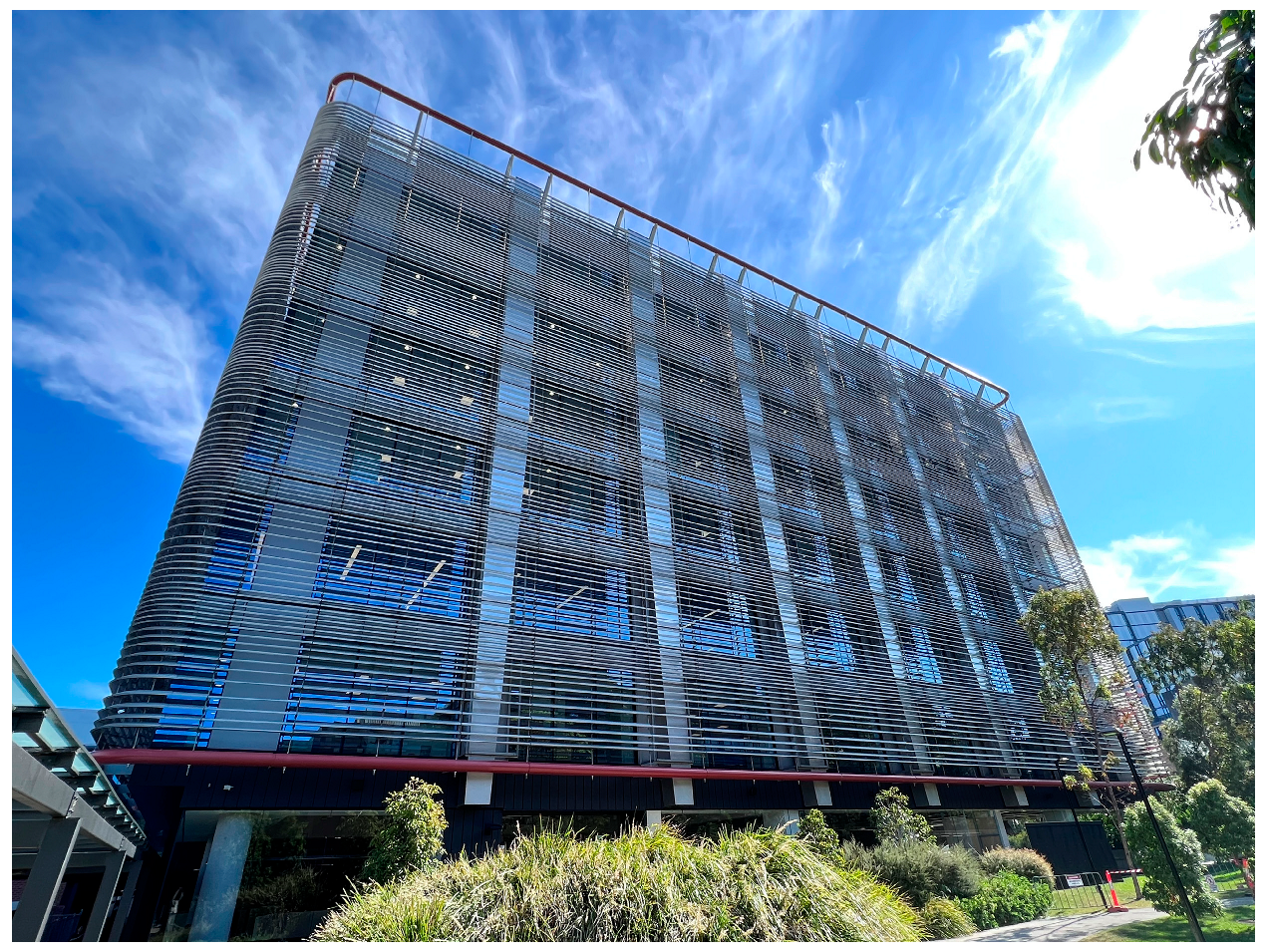
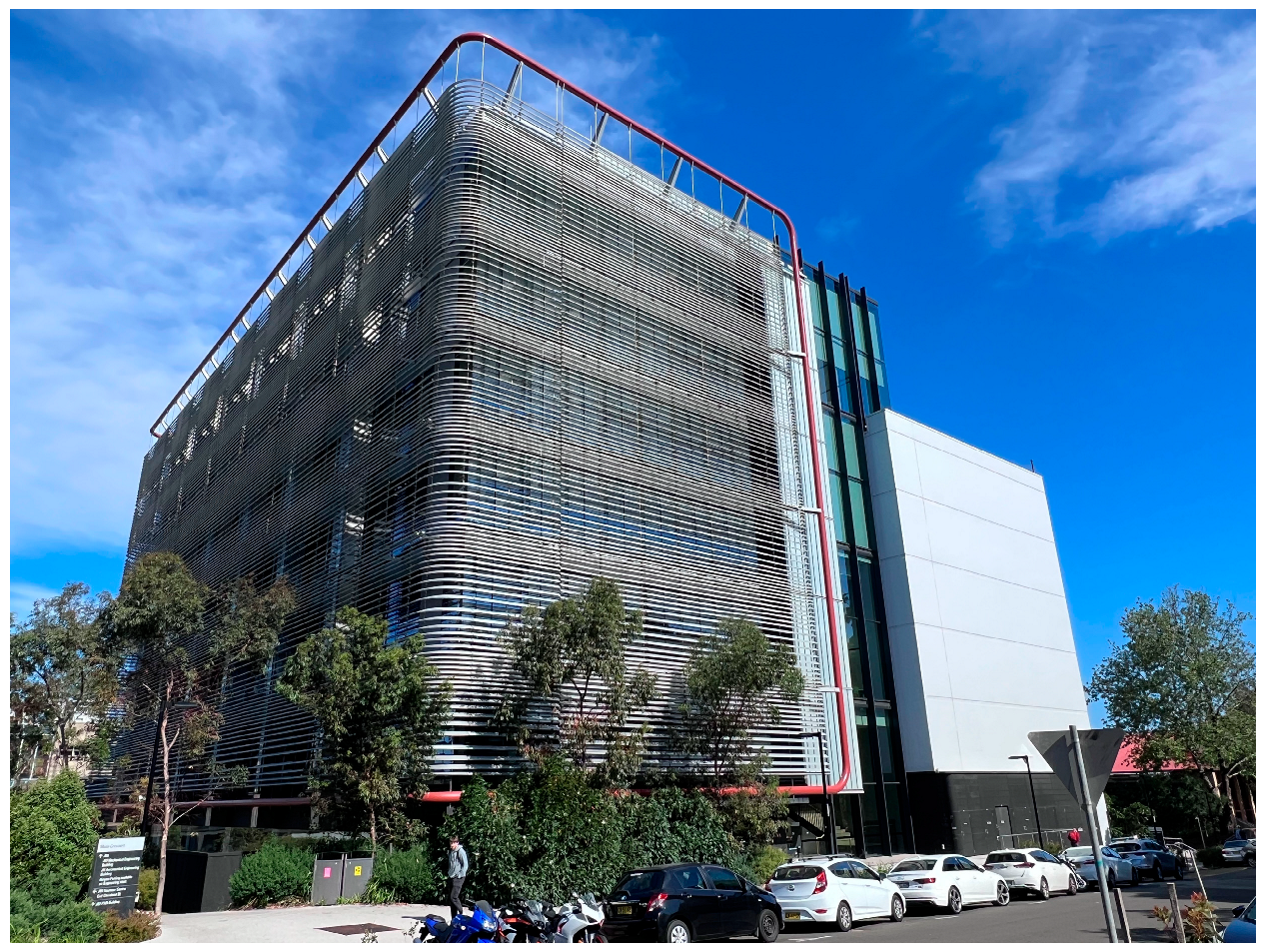

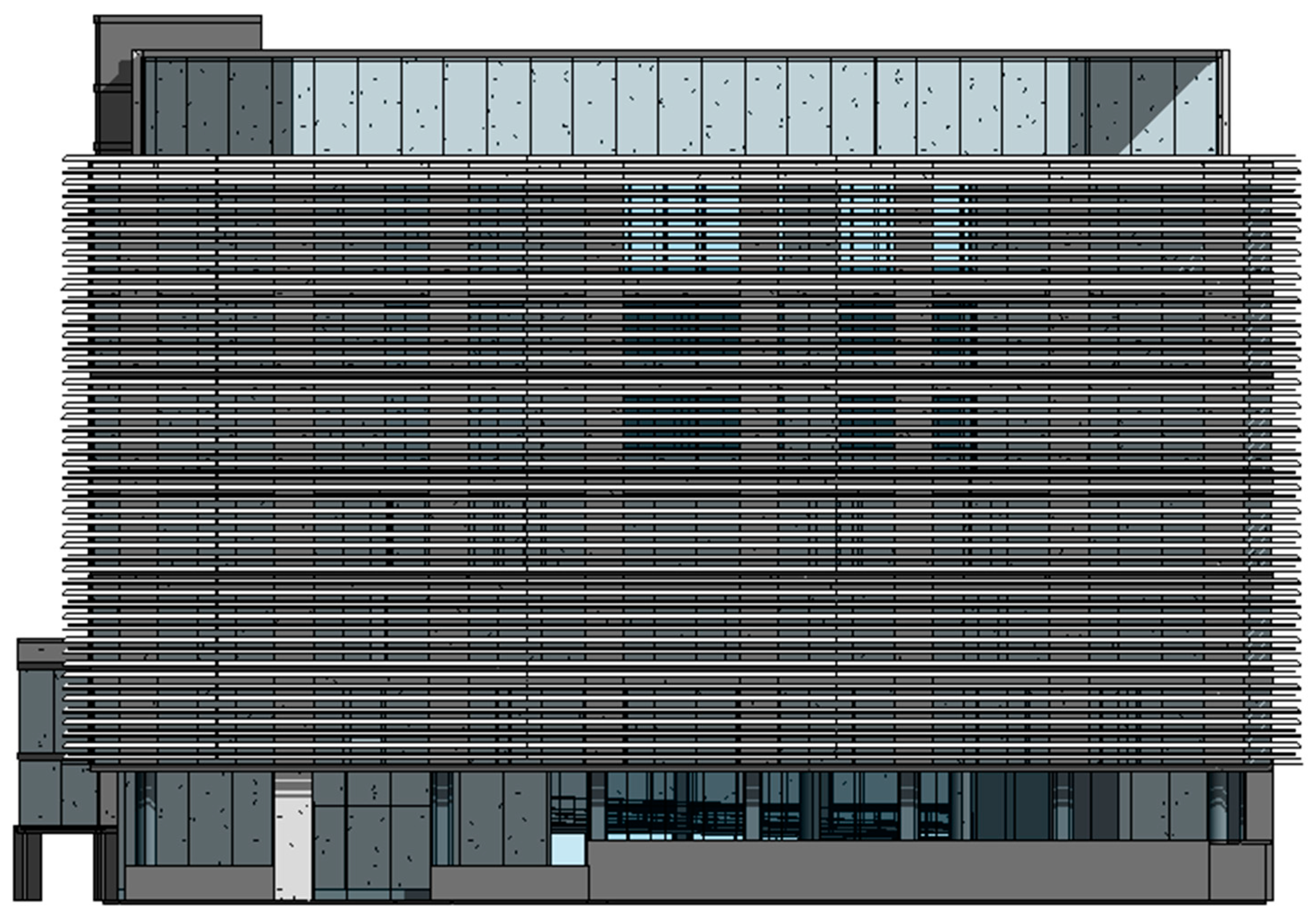

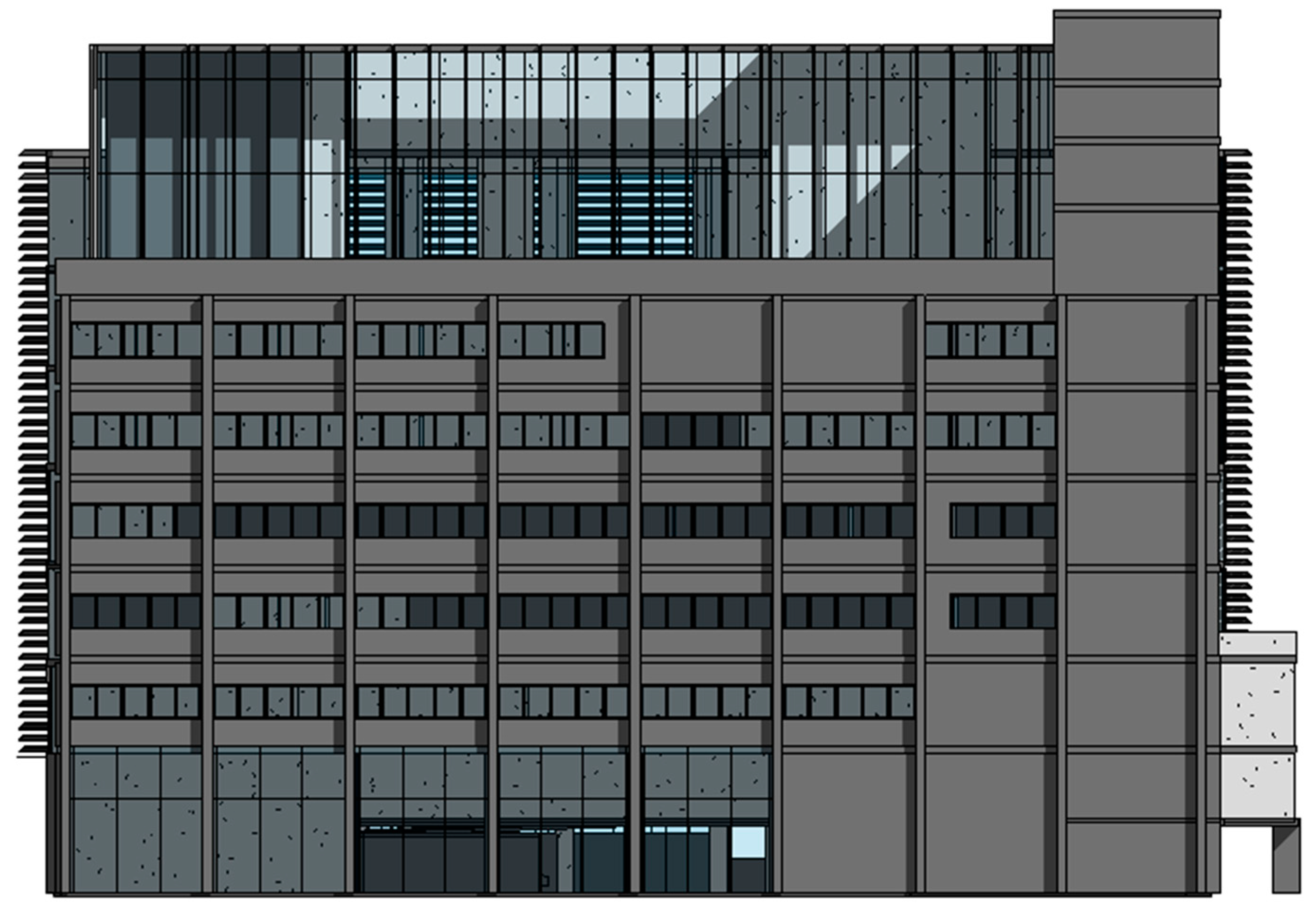
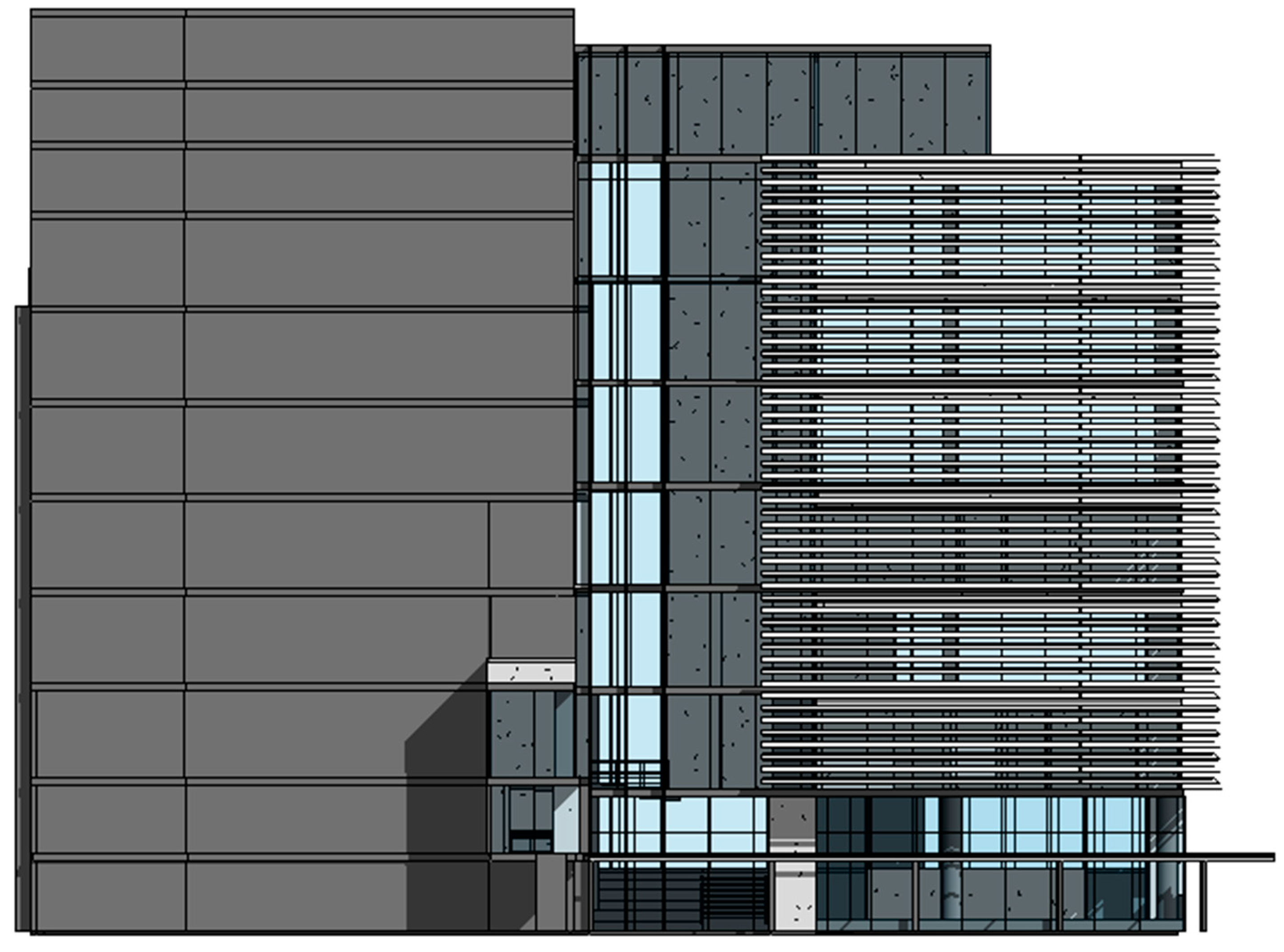
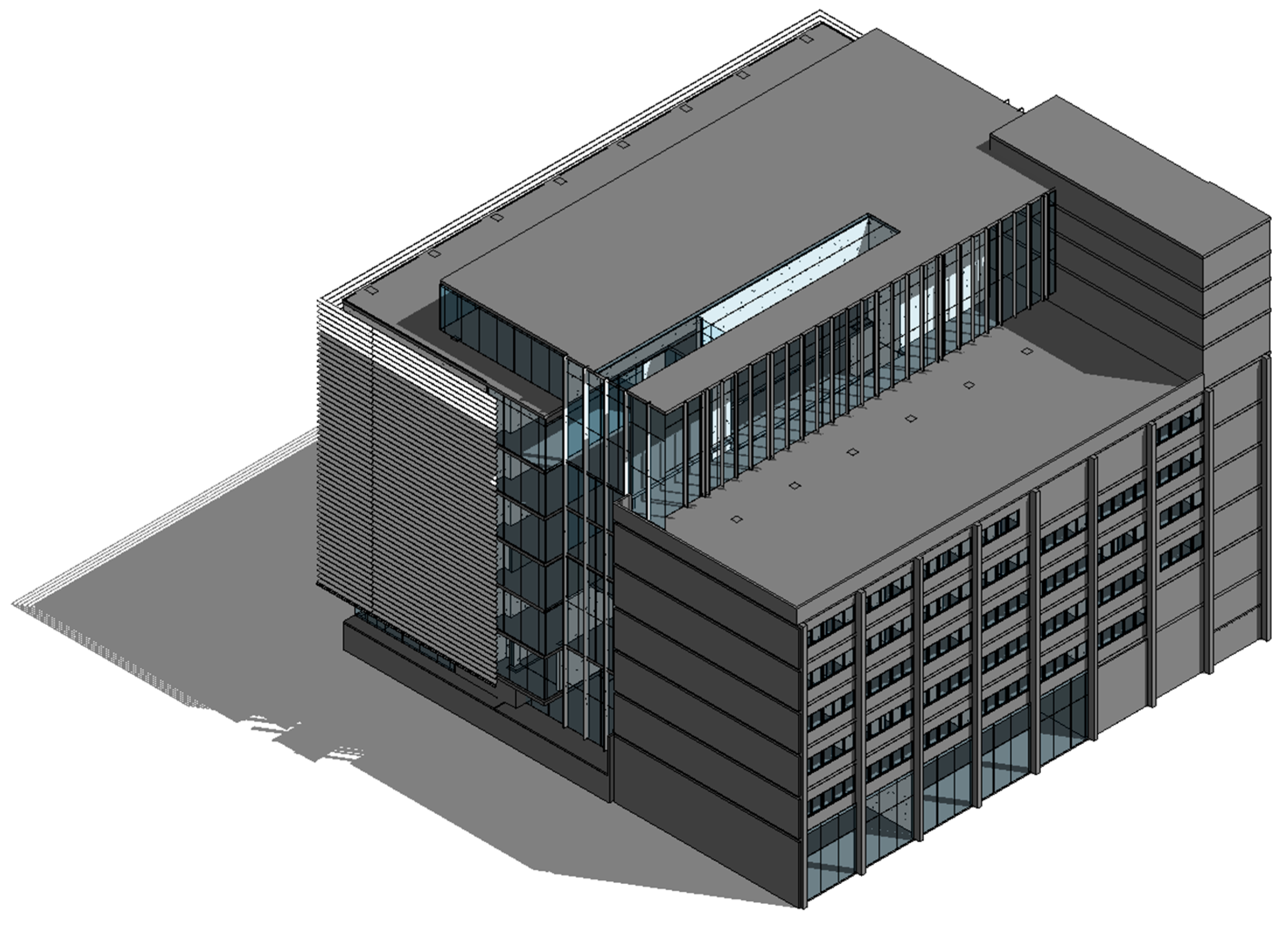
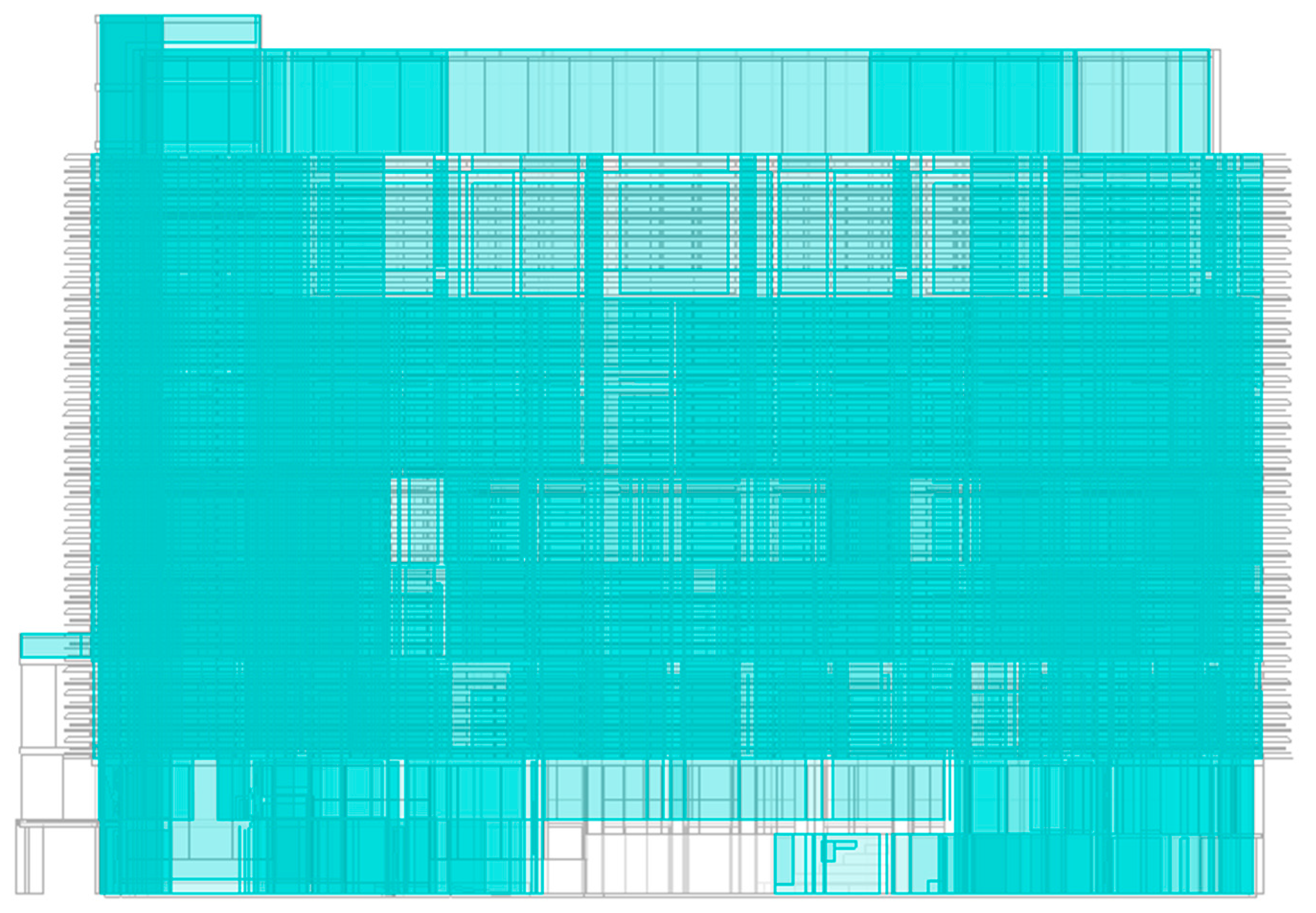
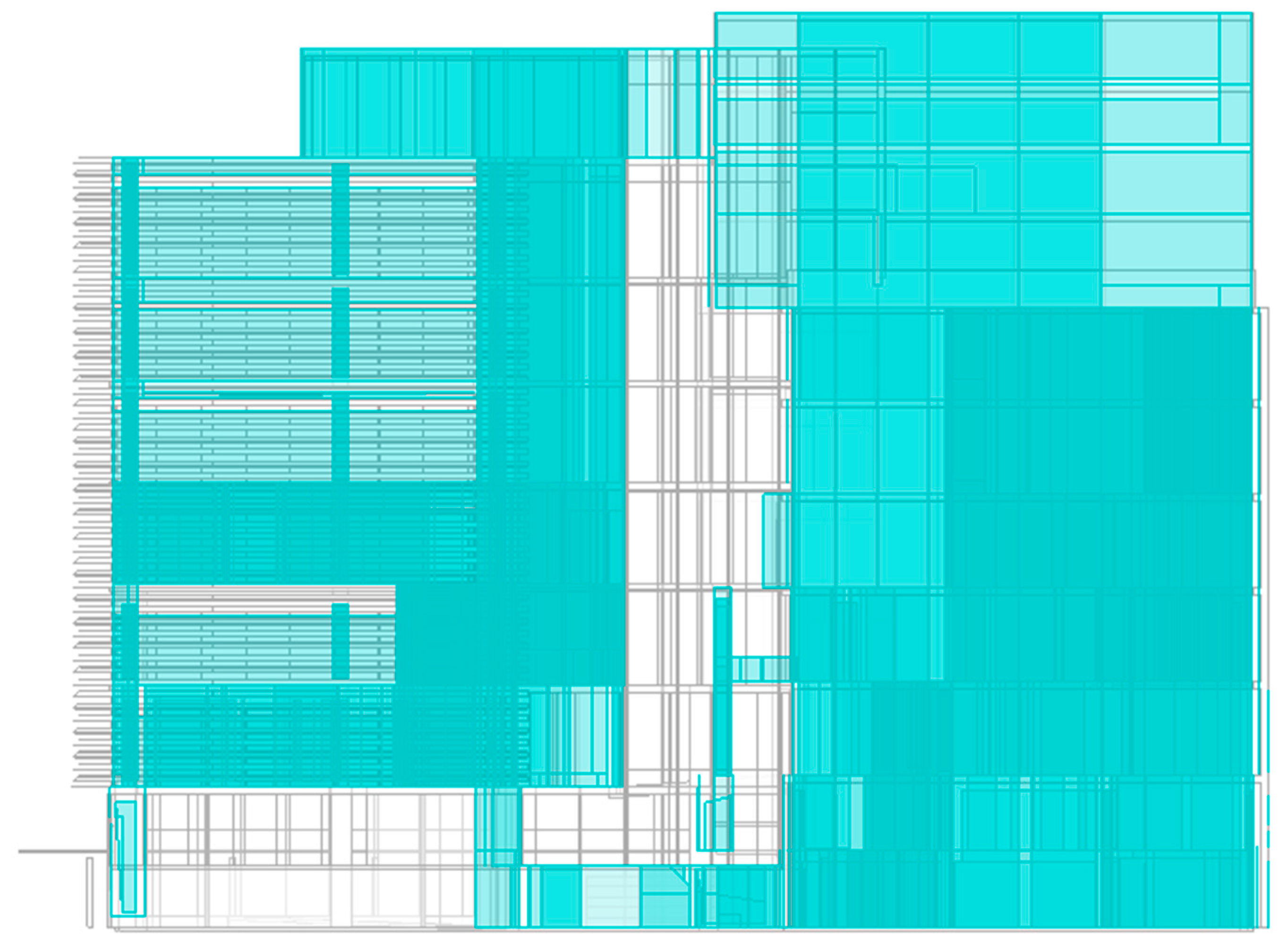
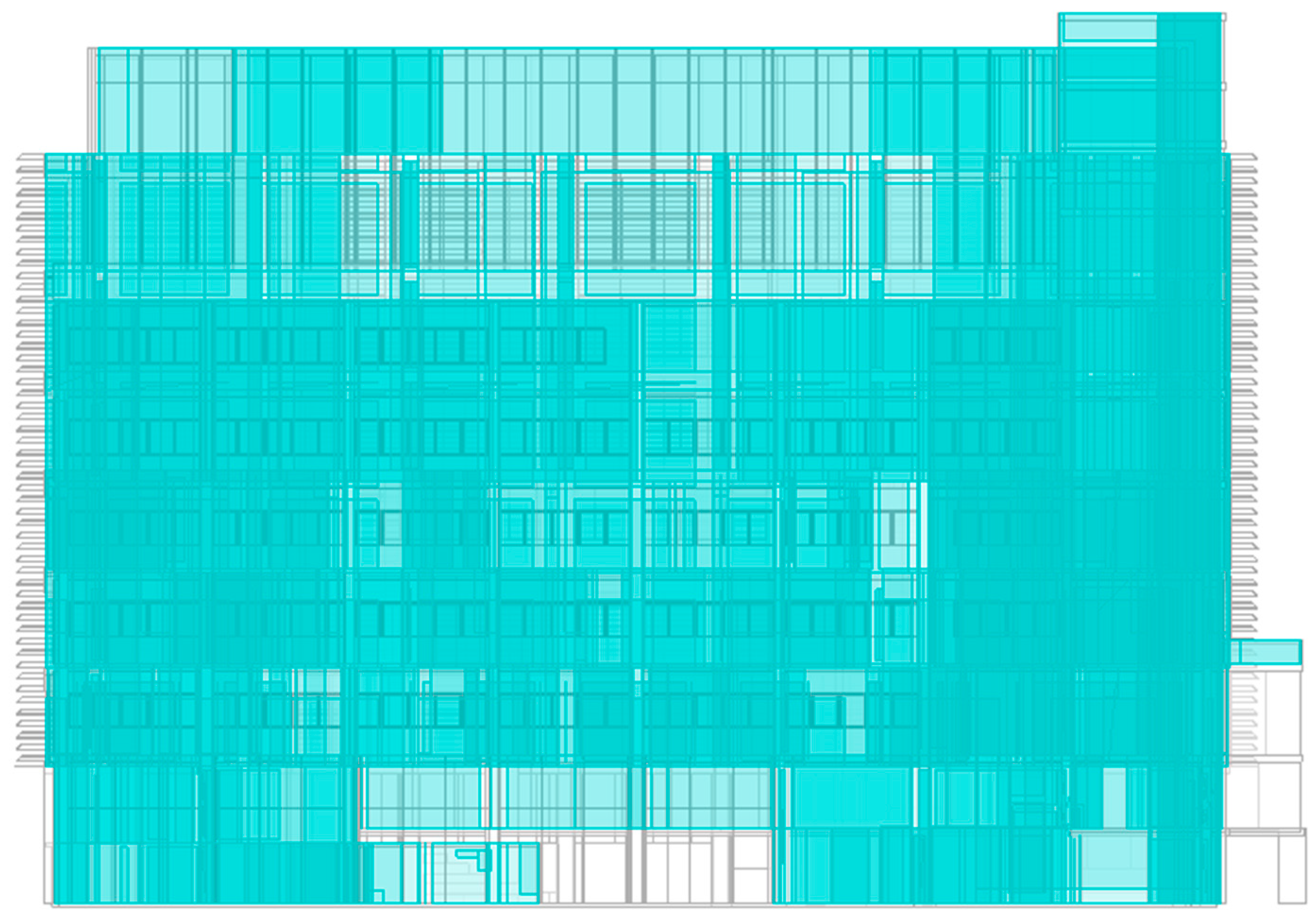
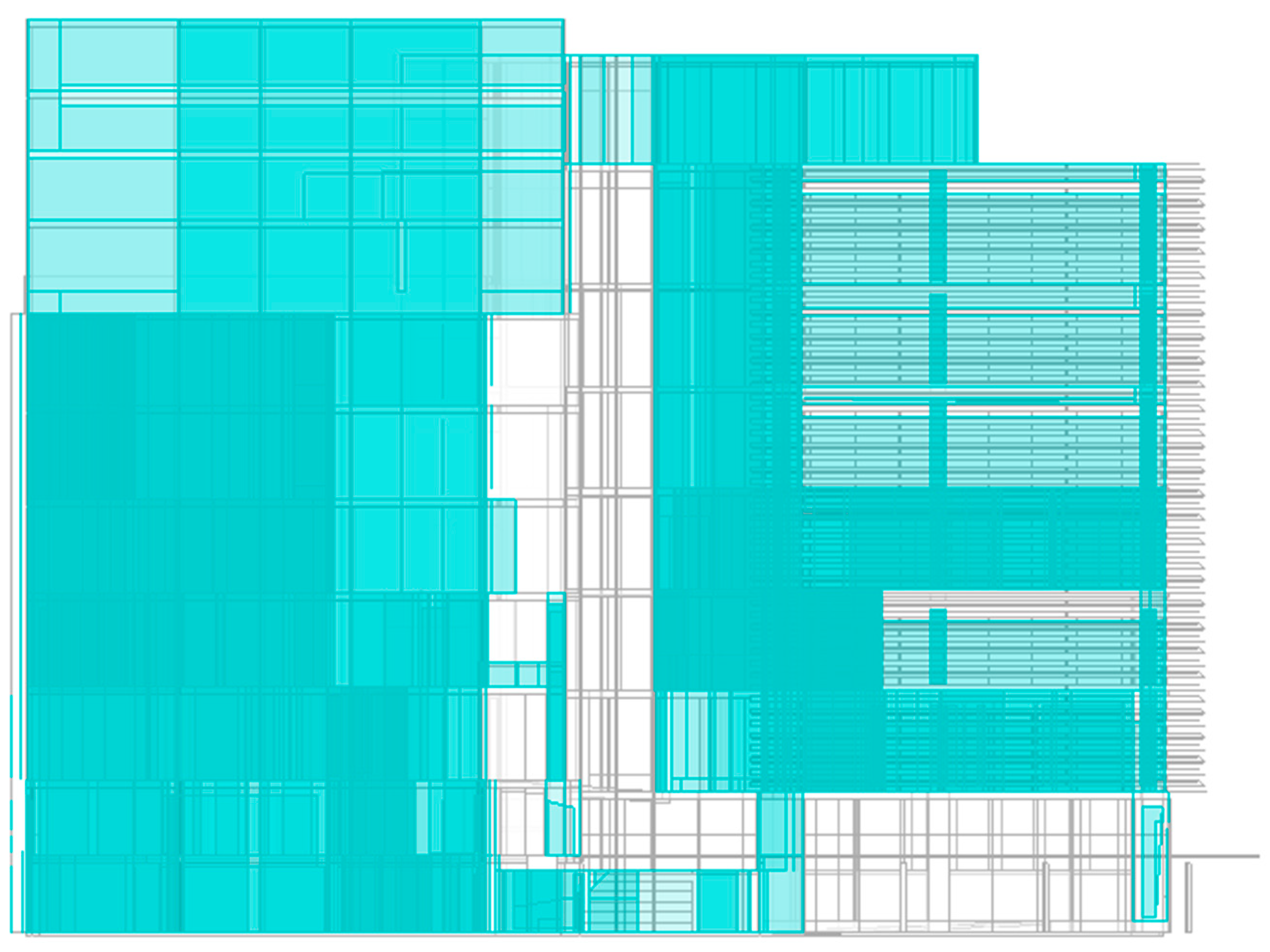
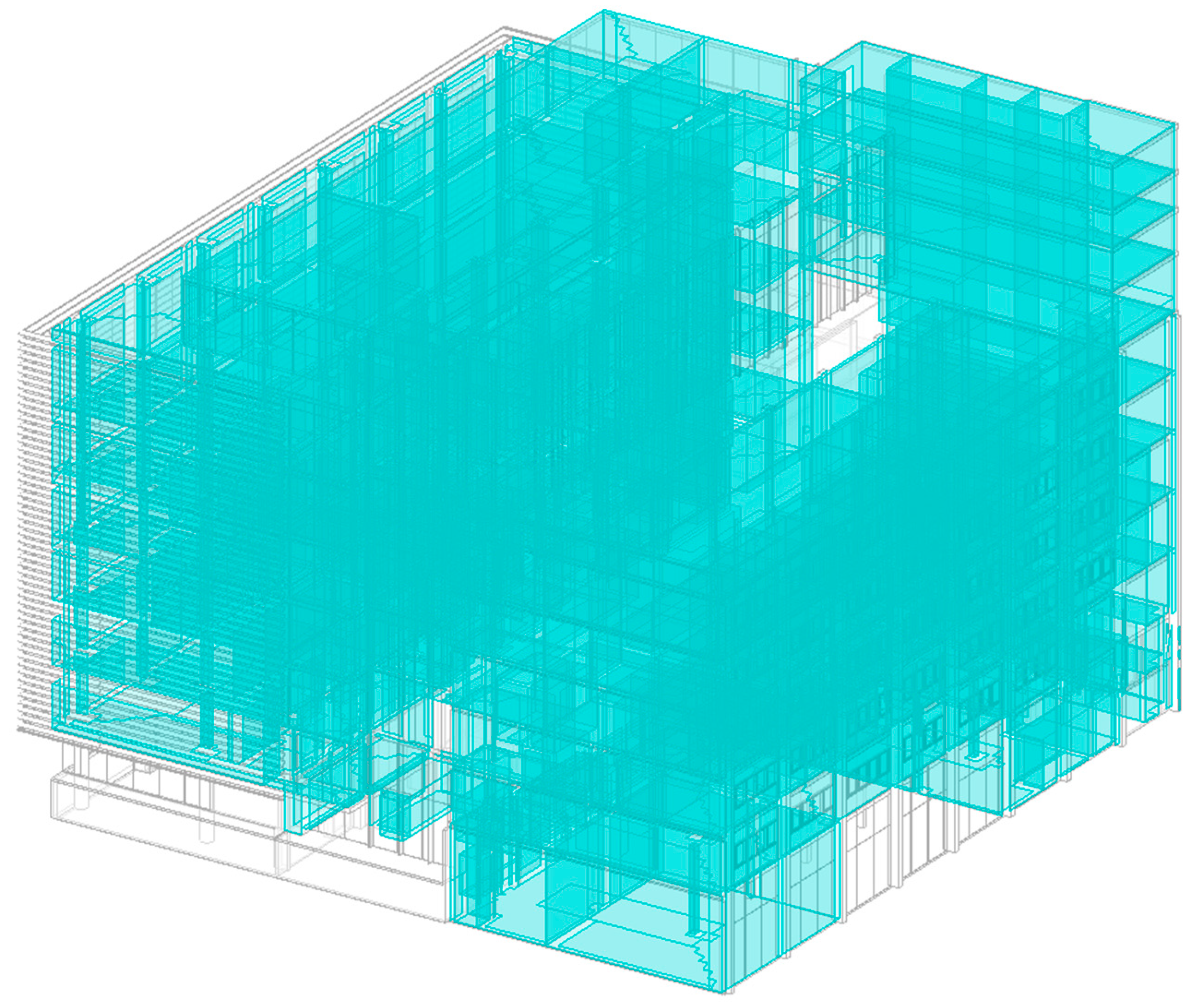
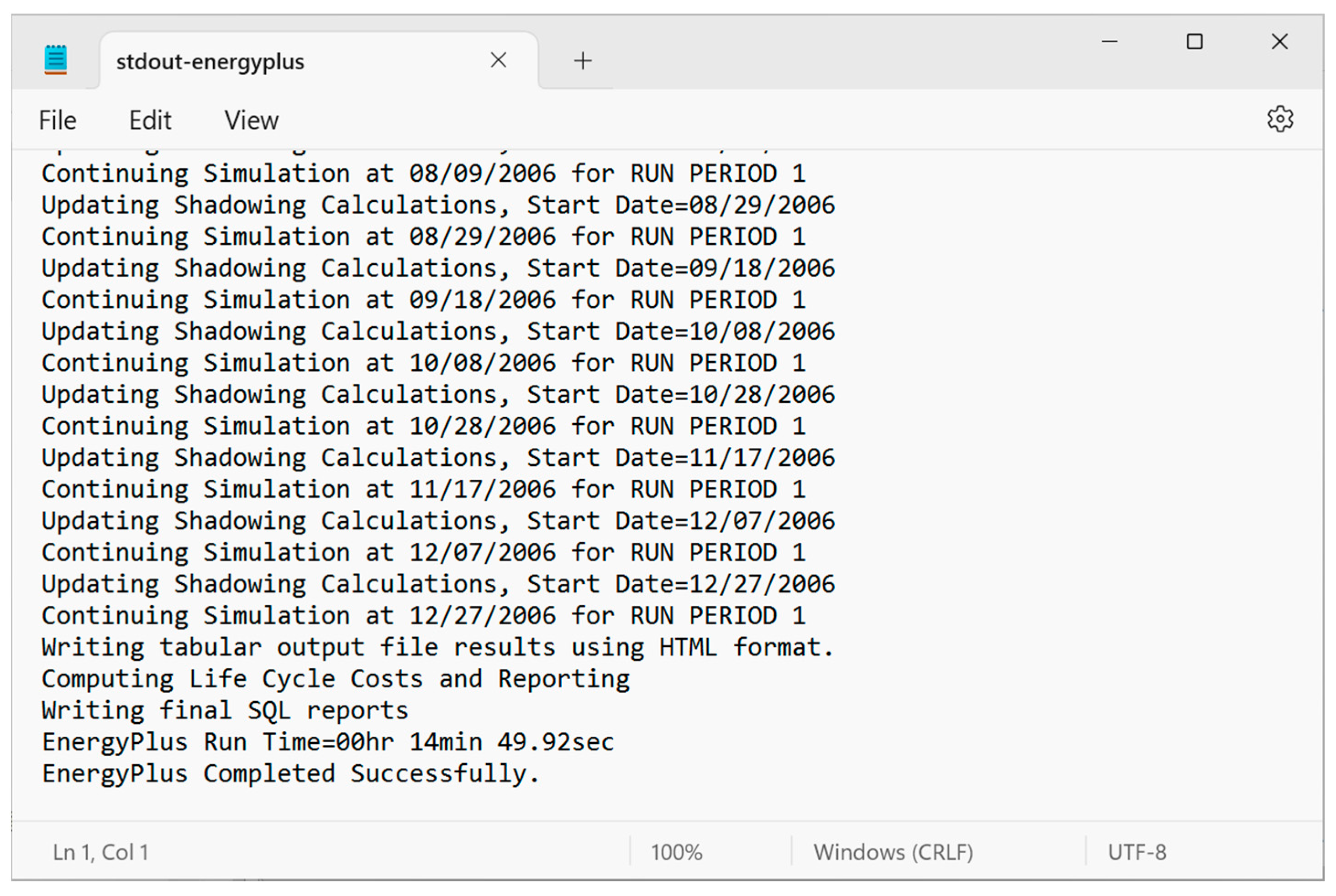


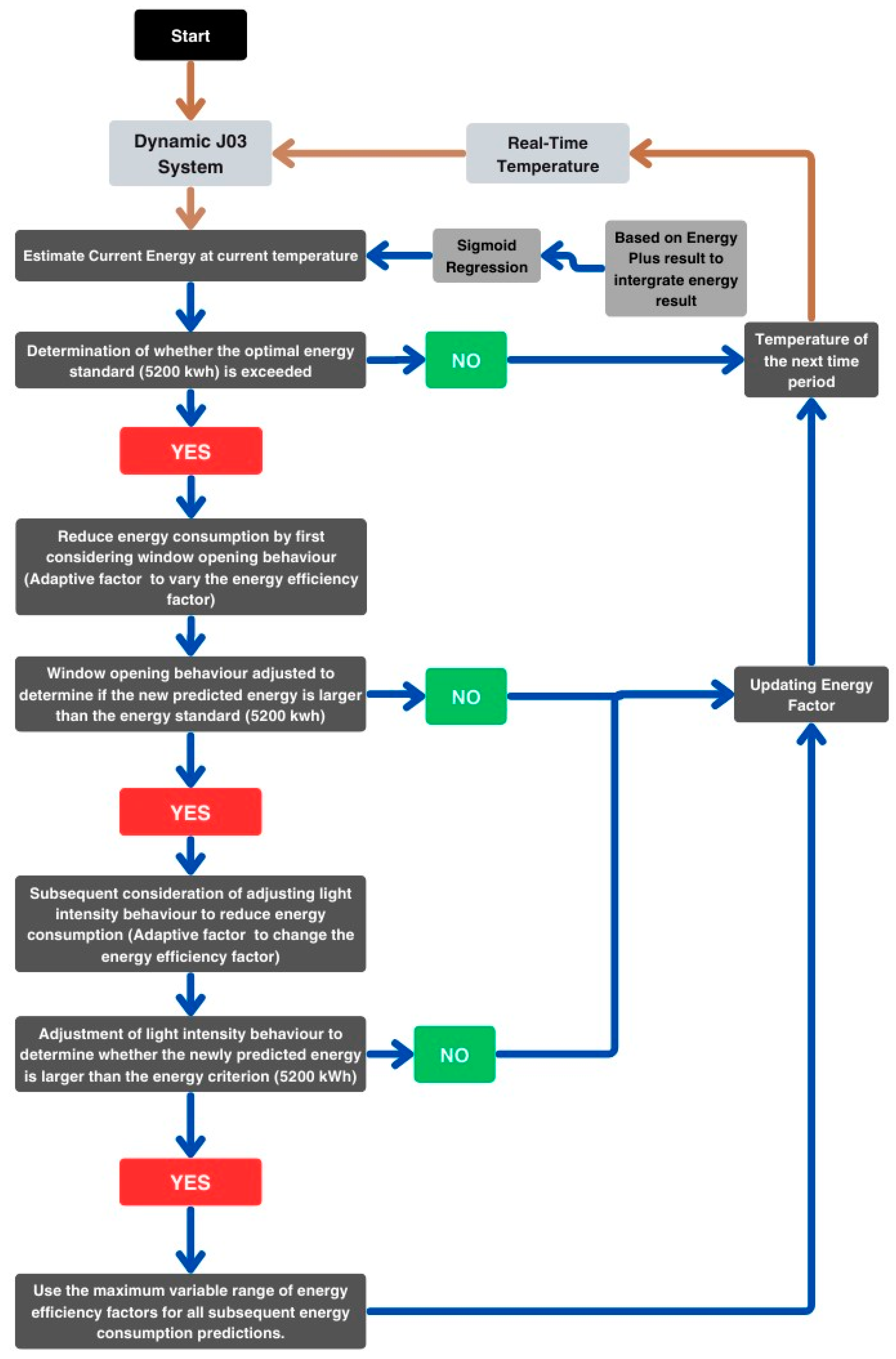
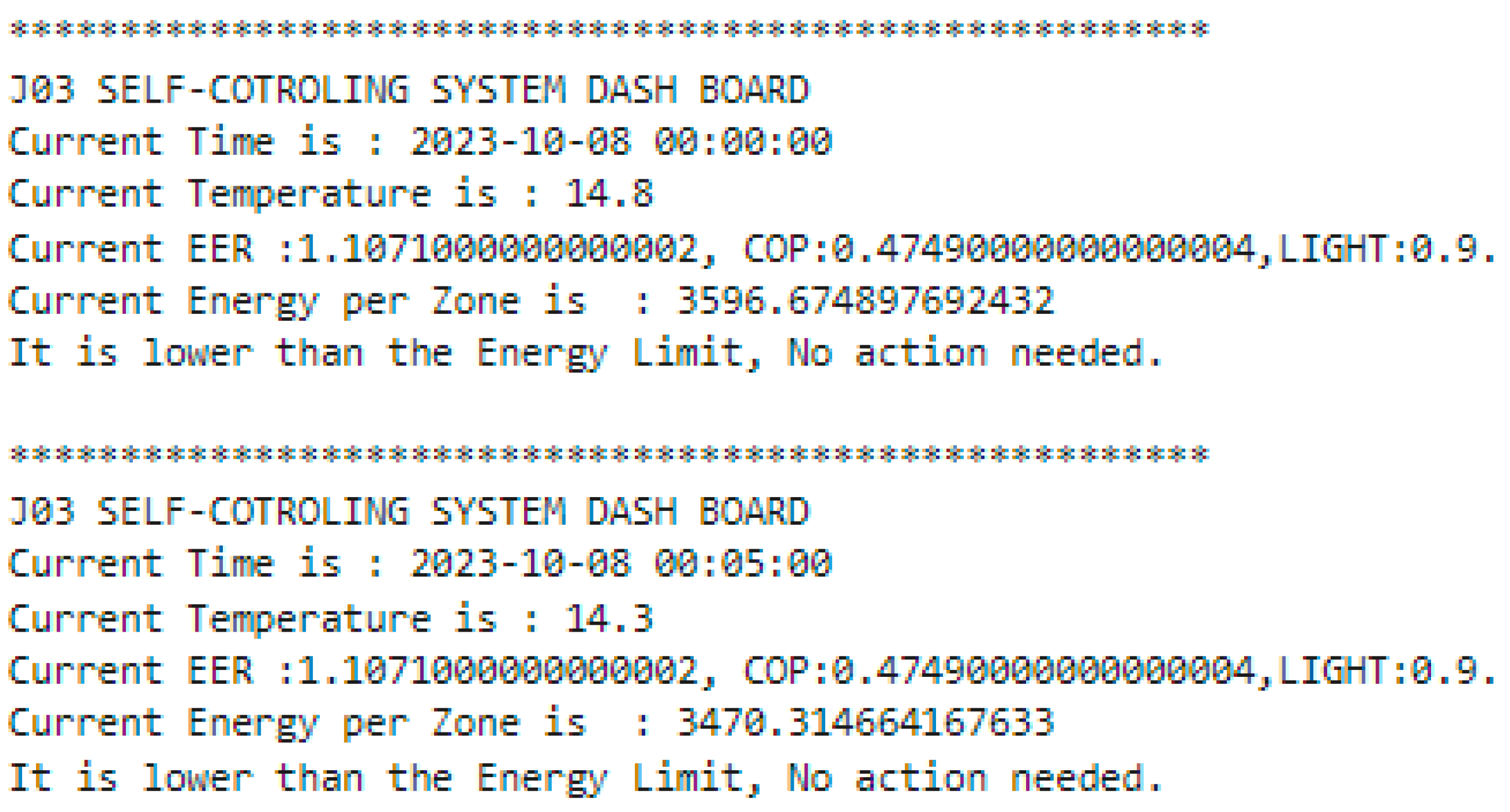

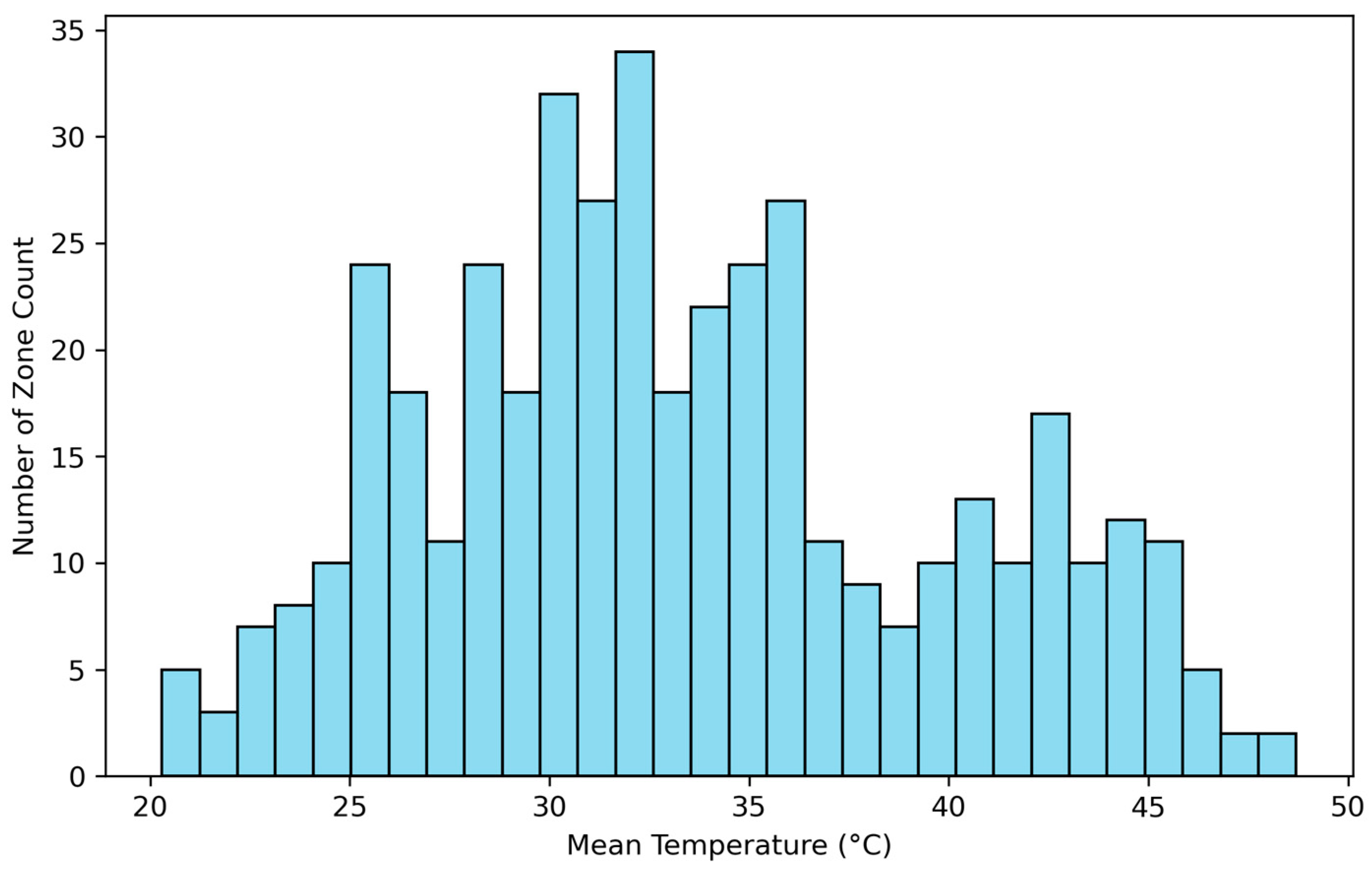

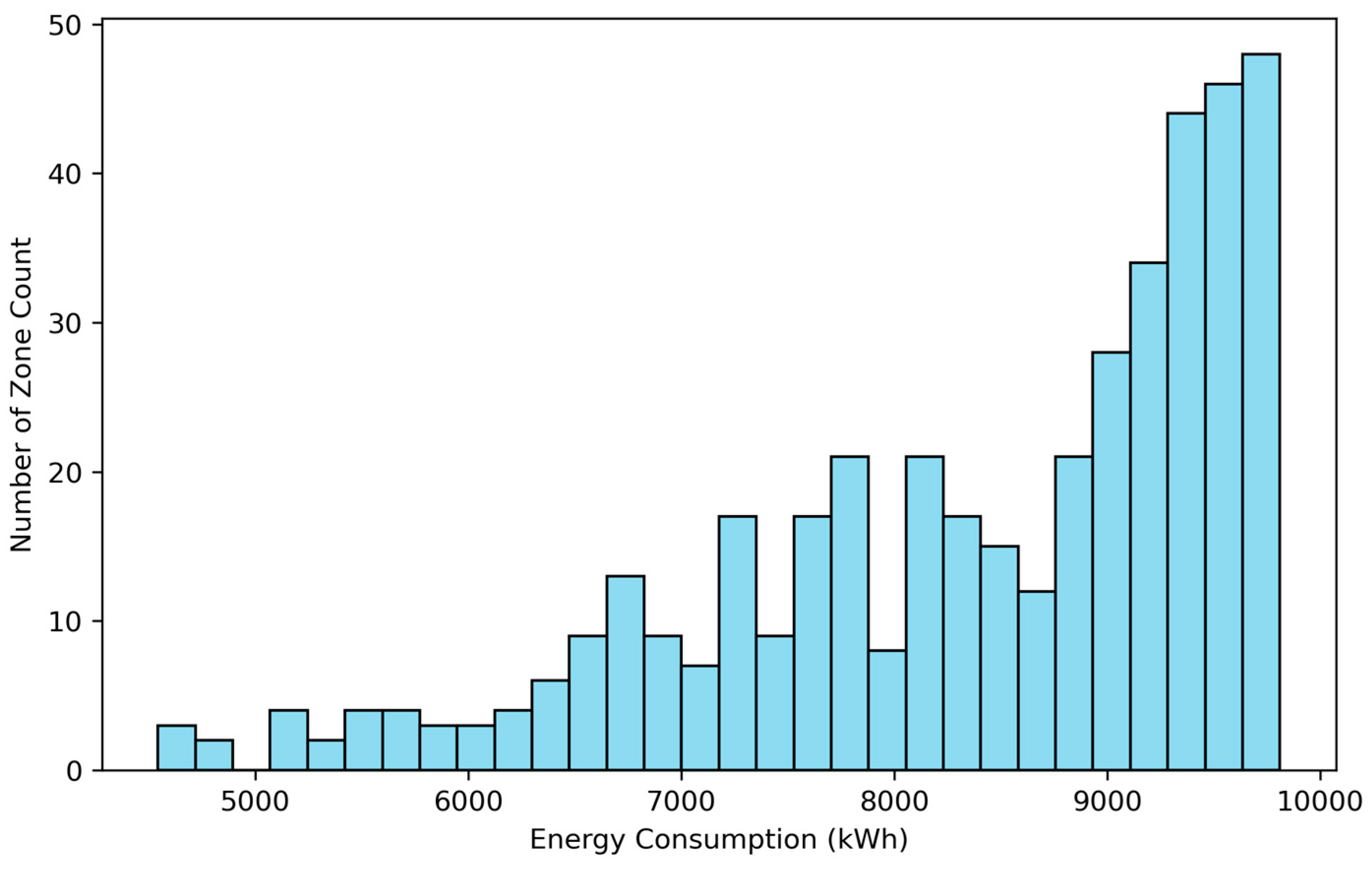
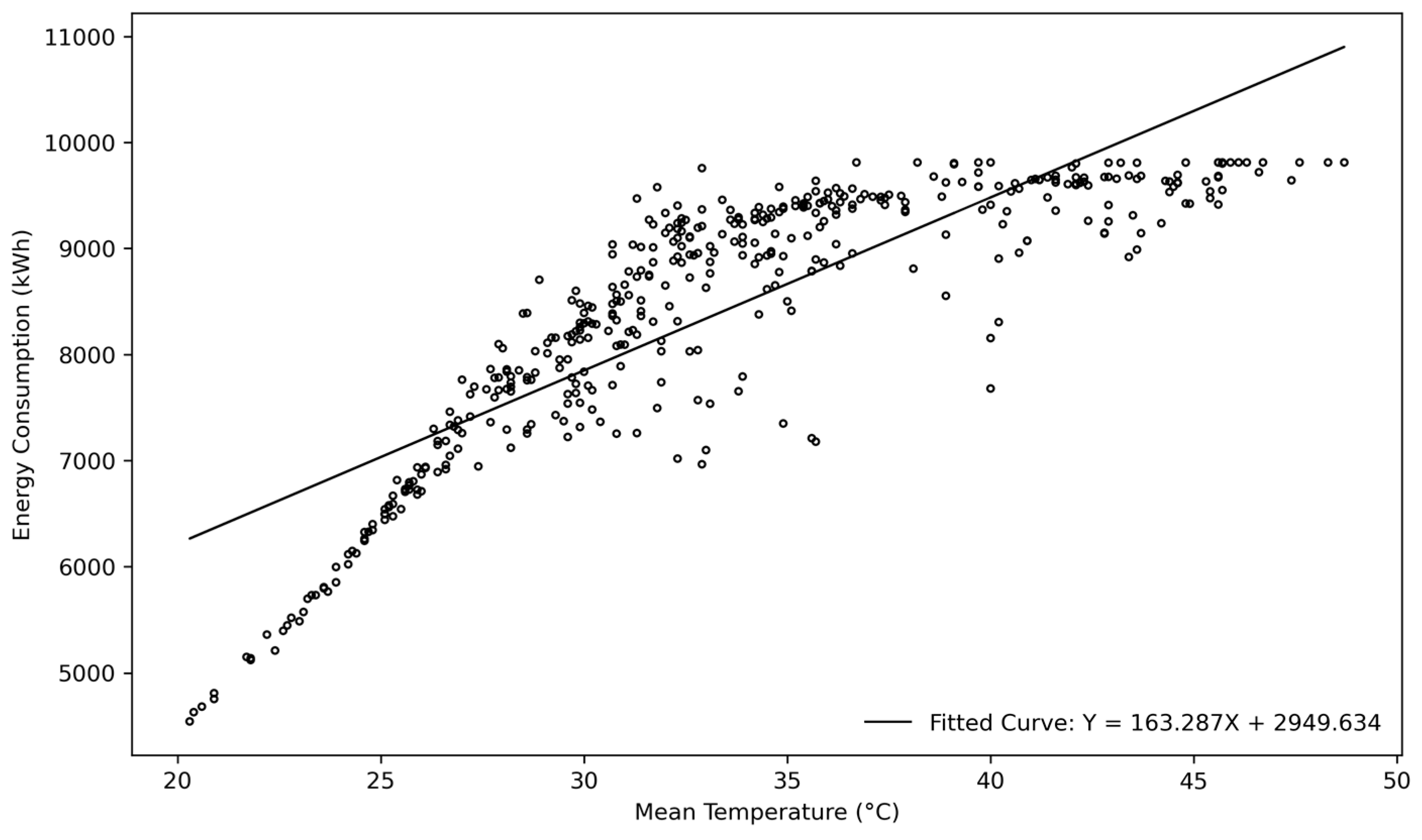
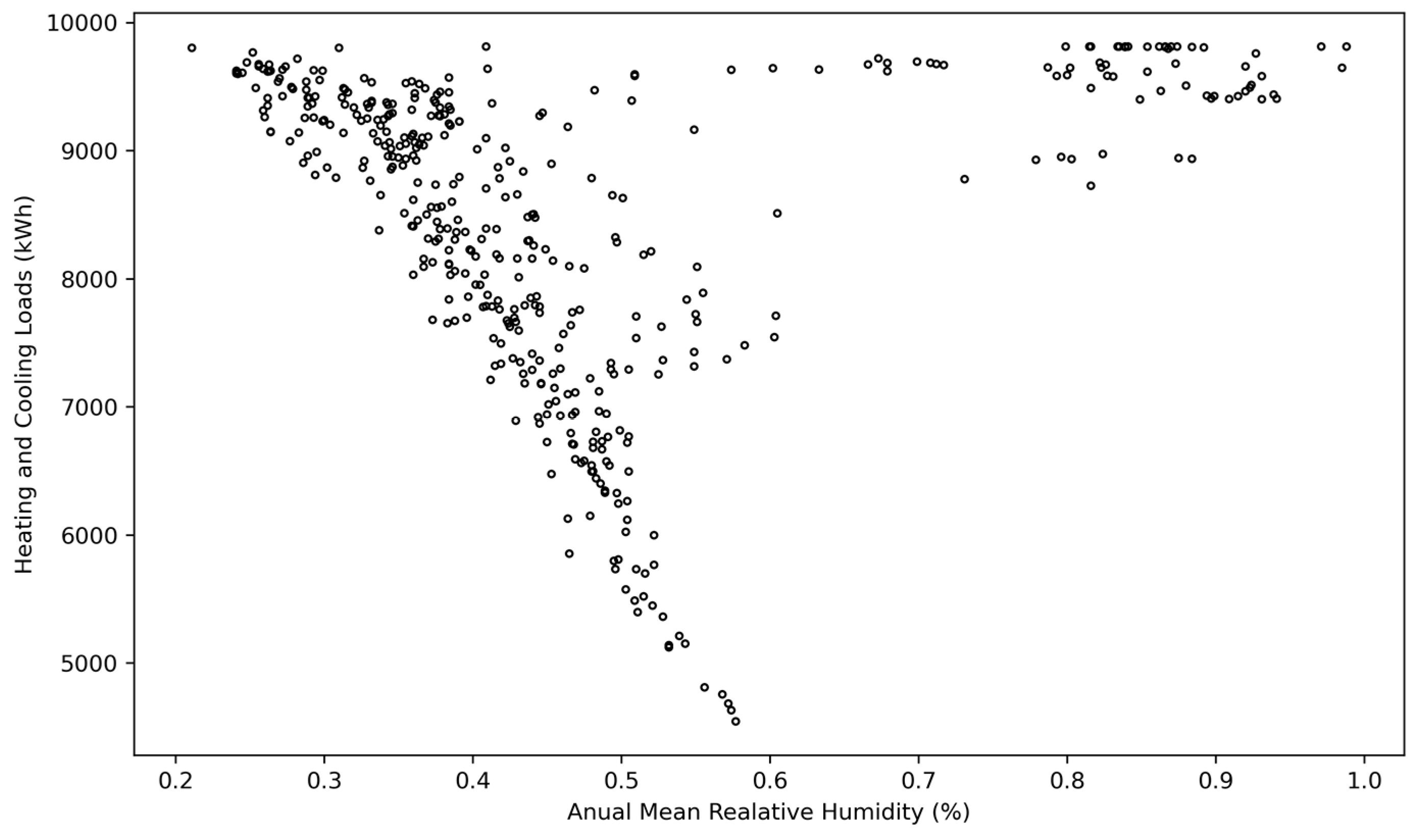
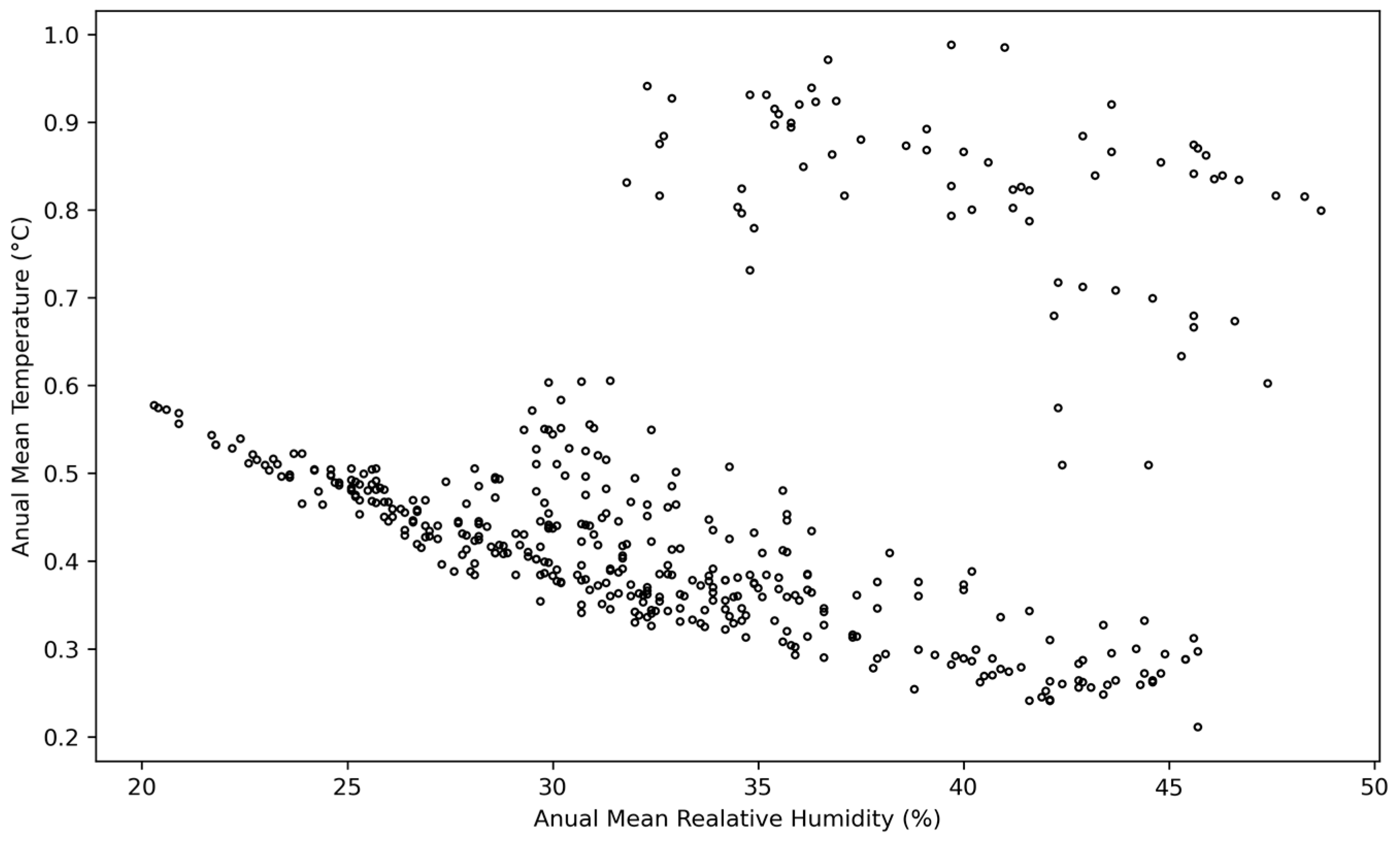
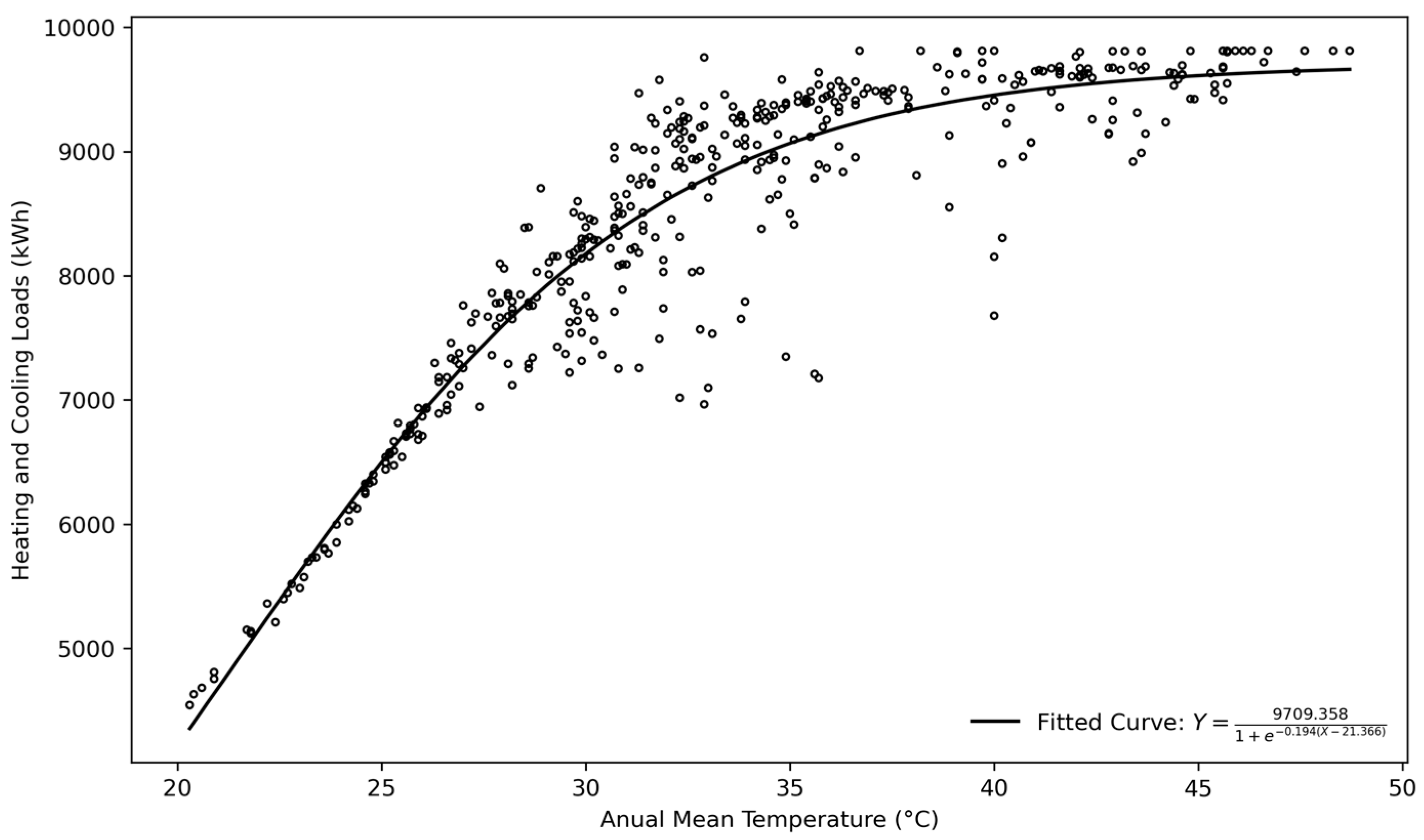
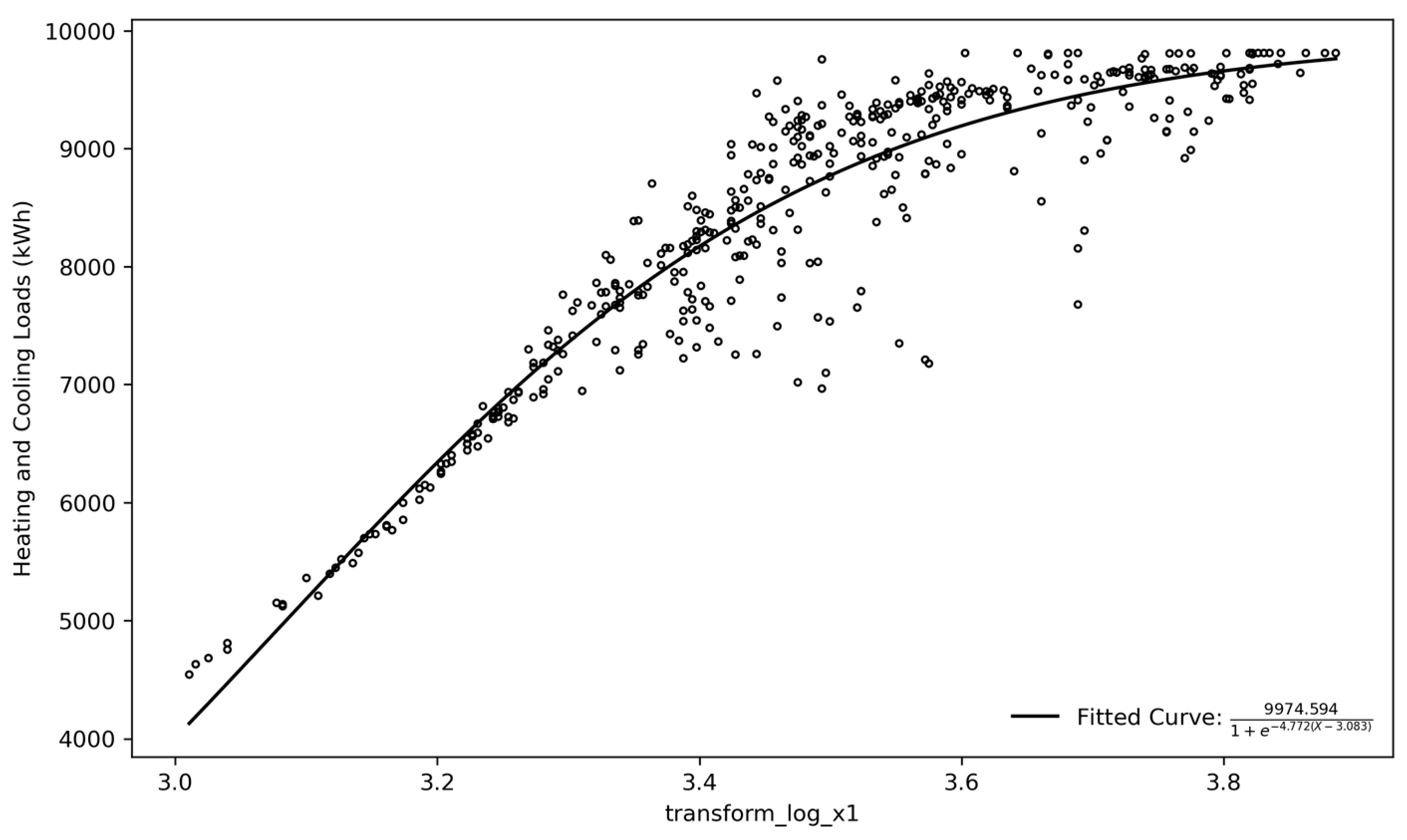
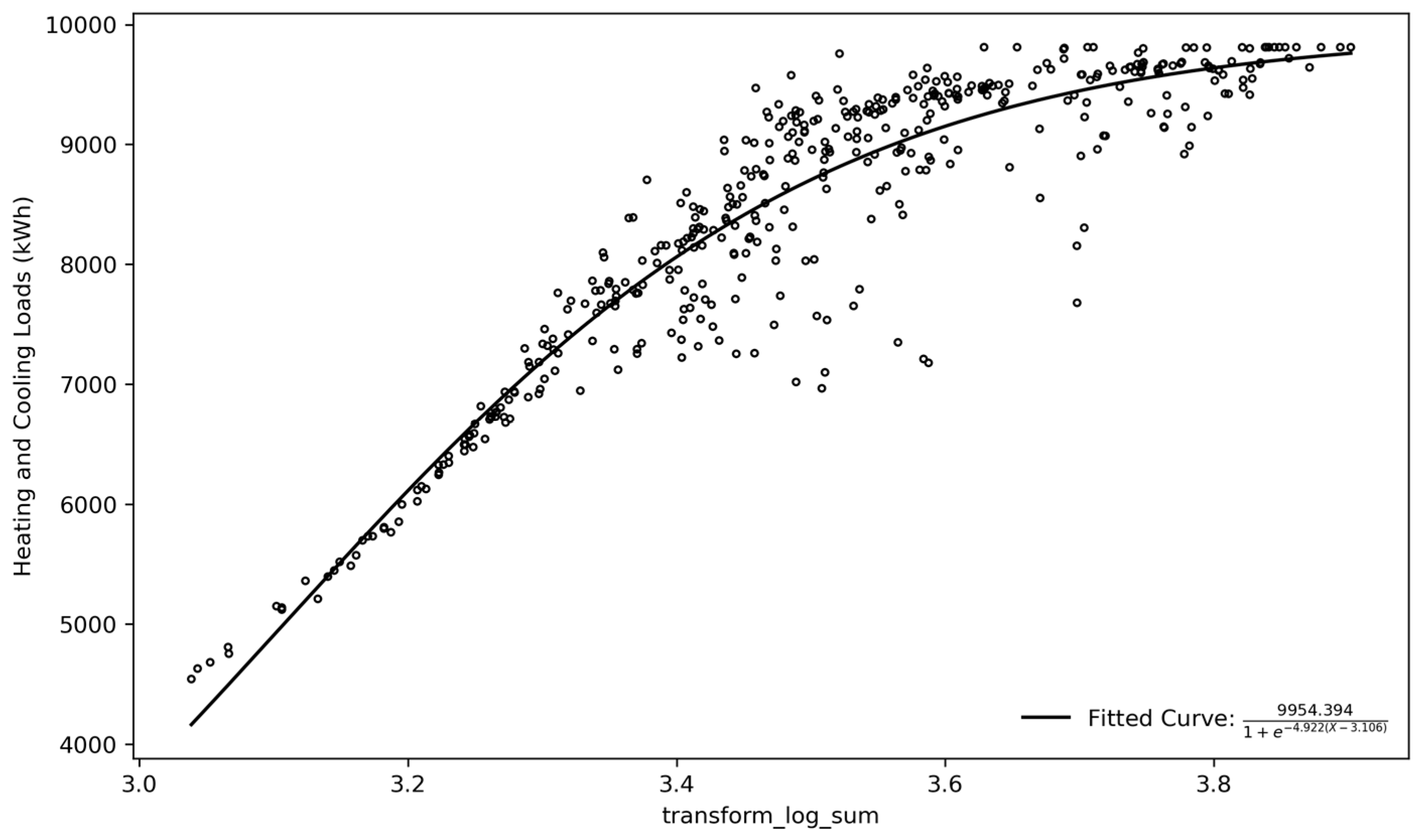

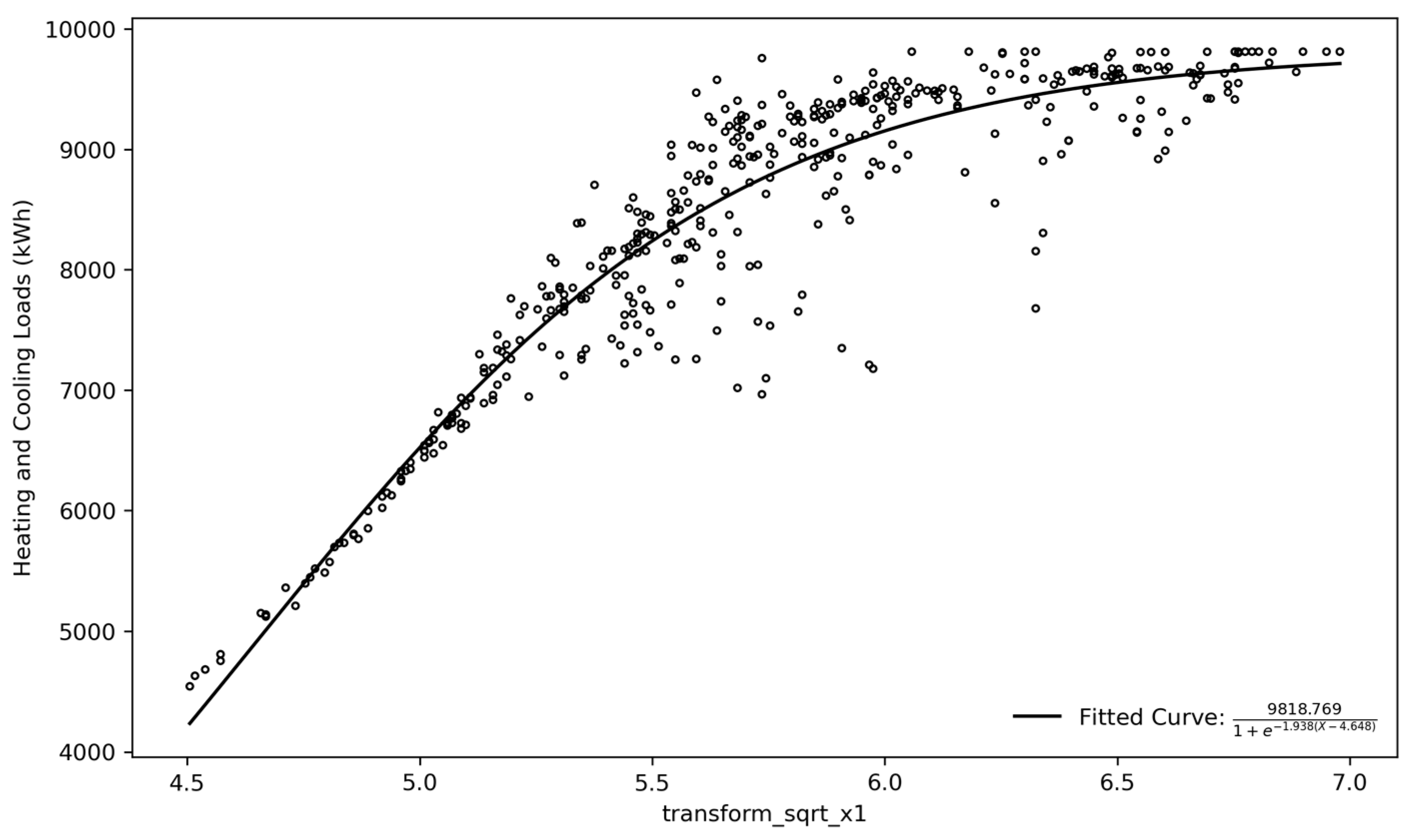
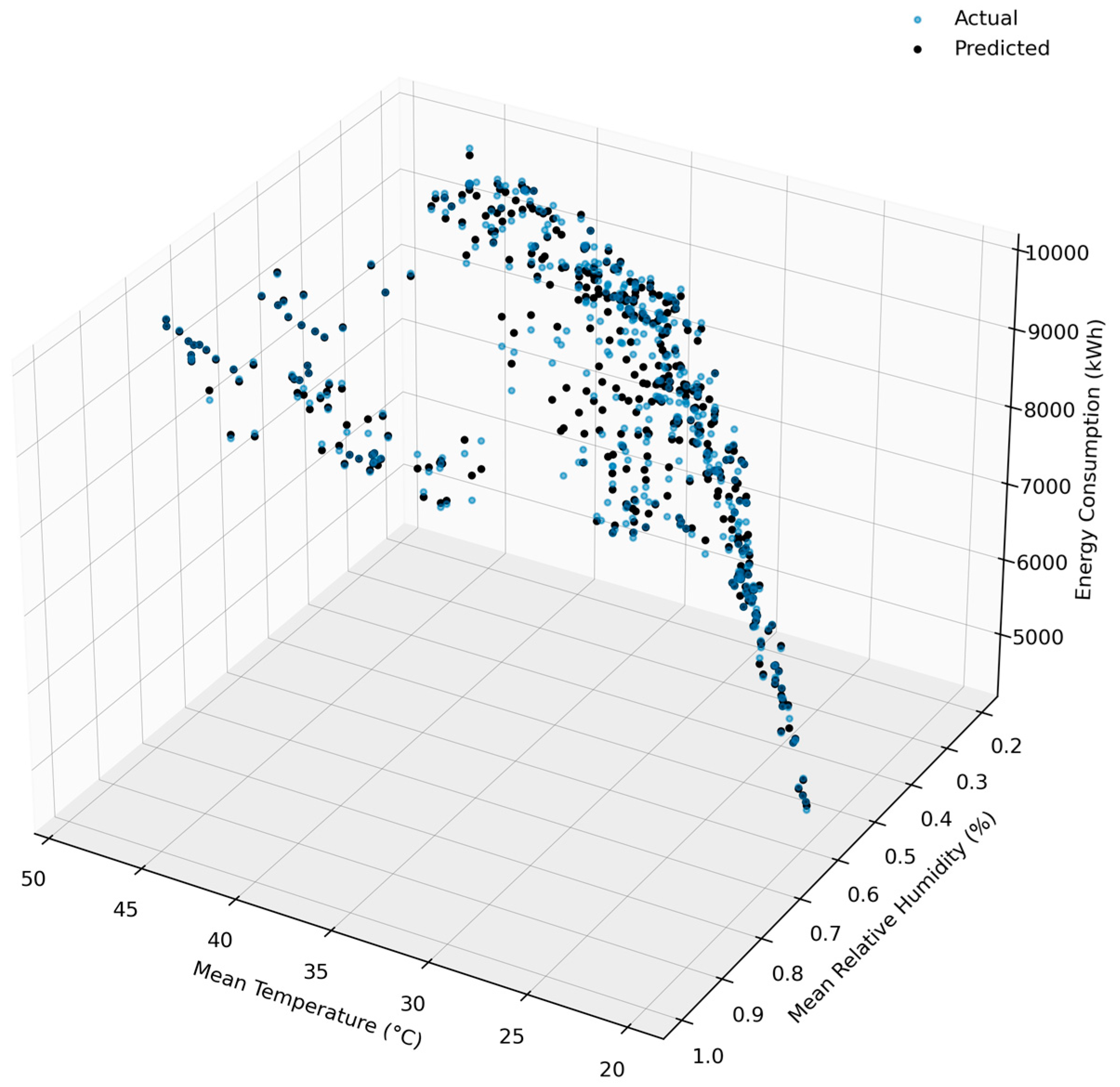
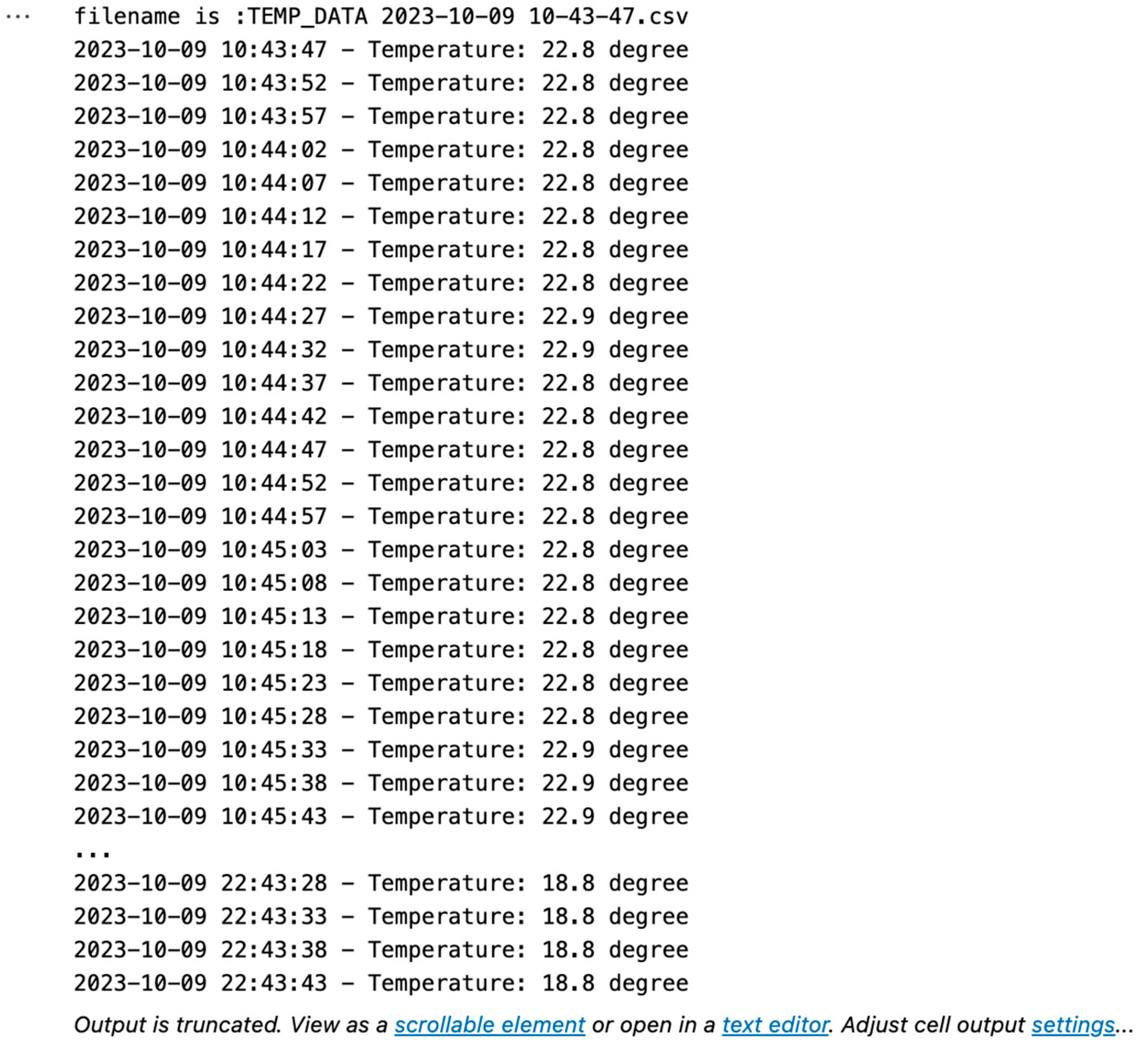
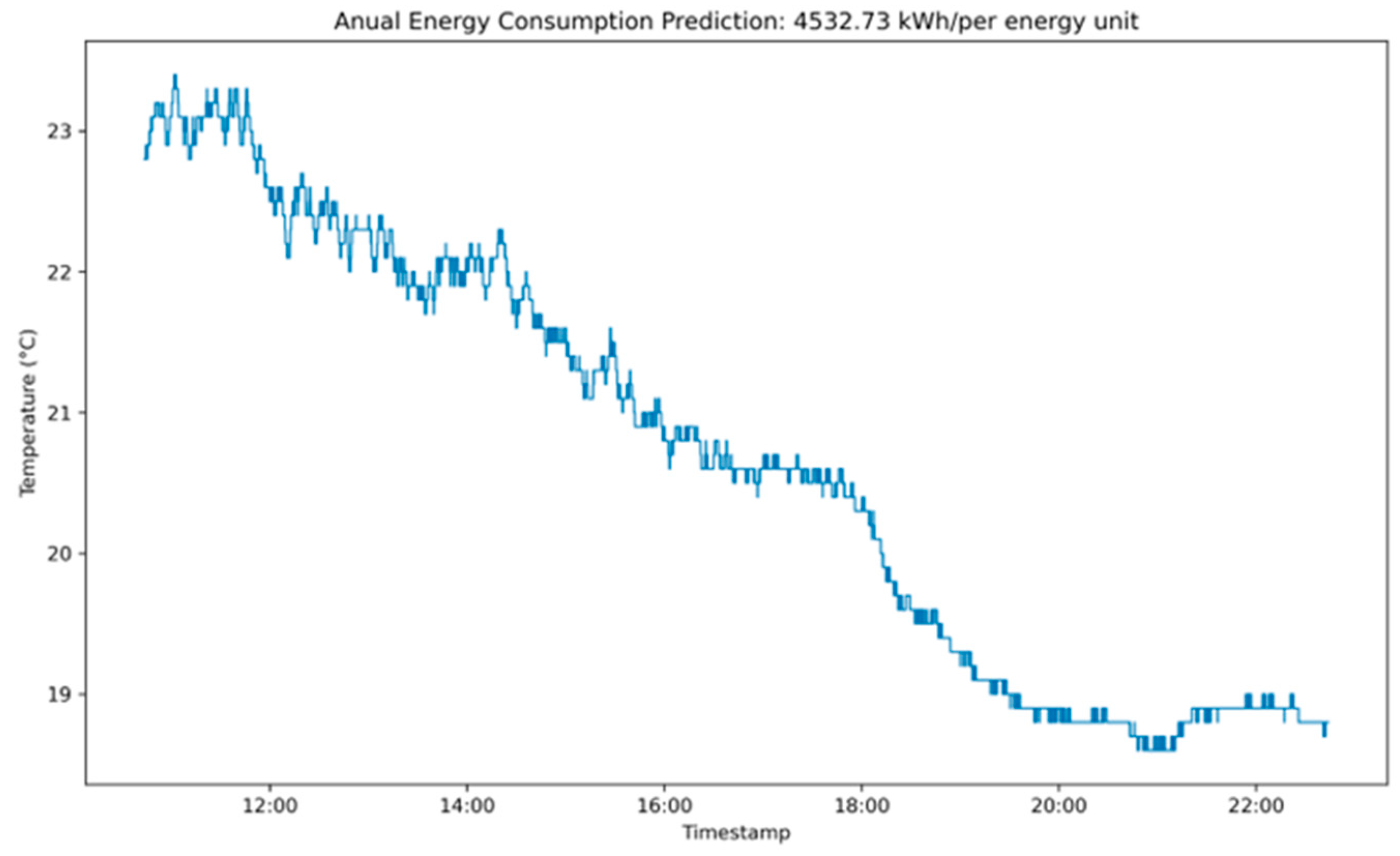


| Zone | Unmet Htg (h) | Unmet Htg—Occ (h) | <56 (F) | 56–61 (F) | 61–66 (F) | 66–68 (F) | 70–72 (F) | 72–74 (F) | 74–76 (F) | 76–78 (F) | 78–83 (F) | 83–88 (F) | ≥ 88 (F) | Unmet Clg (h) | Unmet Clg—Occ (h) | Mean Temp (F) | Mean Relative Humidity (%) |
|---|---|---|---|---|---|---|---|---|---|---|---|---|---|---|---|---|---|
| AIM138958 | 0 | 0 | 0 | 0 | 0 | 0 | 0 | 0 | 6 | 61 | 206 | 244 | 8243 | 0 | 0 | 102.4 (F) | 89.2 |
| AIM138962 | 0 | 0 | 7 | 399 | 675 | 929 | 675 | 712 | 677 | 1375 | 1158 | 781 | 801 | 0 | 0 | 74.6 (F) | 52.2 |
| AIM138966 | 0 | 0 | 49 | 571 | 780 | 1052 | 684 | 668 | 636 | 1199 | 1078 | 730 | 642 | 0 | 0 | 73.4 (F) | 50.9 |
| AIM138970 | 0 | 0 | 0 | 24 | 151 | 429 | 396 | 452 | 567 | 1226 | 1350 | 1347 | 2525 | 0 | 0 | 81.0 (F) | 42.5 |
| AIM138974 | 0 | 0 | 29 | 341 | 474 | 678 | 496 | 510 | 514 | 1080 | 1141 | 975 | 2102 | 0 | 0 | 78.4 (F) | 48.3 |
| Zone | Mean_Temp | Mean_Relative_Humidity | Energy_Consumption |
|---|---|---|---|
| AIM138958 | 39.1 | 0.892 | 9804.480 |
| AIM138962 | 23.7 | 0.522 | 5765.088 |
| AIM138966 | 23.0 | 0.509 | 5485.984 |
| AIM138970 | 27.2 | 0.425 | 7623.616 |
| AIM138974 | 25.8 | 0.483 | 6803.776 |
| X | MSE | |
|---|---|---|
| (original) | 177,377 | 0.883 |
| ) | 180,369 | 0.8805 |
| ) | 180,513 | 0.8804 |
| 177,935 | 0.8821 | |
| 178,600 | 0.8817 |
| Linear | Sigmoid | Random Forest | |
|---|---|---|---|
| Variables | X = mean temp | X = mean temp | X1 = mean temp |
| R square | Y = energy consumption | Y = energy consumption | X2 = mean humidity Y = energy consumption |
| MSE | 0.717 | 0.883 | 0.834 |
| AIC | 426,522 | 177,377 | 207,309 |
| BIC | 6814.39 | 6814.39 | 6828.16 |
Disclaimer/Publisher’s Note: The statements, opinions and data contained in all publications are solely those of the individual author(s) and contributor(s) and not of MDPI and/or the editor(s). MDPI and/or the editor(s) disclaim responsibility for any injury to people or property resulting from any ideas, methods, instructions or products referred to in the content. |
© 2024 by the authors. Licensee MDPI, Basel, Switzerland. This article is an open access article distributed under the terms and conditions of the Creative Commons Attribution (CC BY) license (https://creativecommons.org/licenses/by/4.0/).
Share and Cite
Tahmasebinia, F.; Lin, L.; Wu, S.; Kang, Y.; Sepesgozar, S. Advanced Energy Performance Modelling: Case Study of an Engineering and Technology Precinct. Buildings 2024, 14, 1774. https://doi.org/10.3390/buildings14061774
Tahmasebinia F, Lin L, Wu S, Kang Y, Sepesgozar S. Advanced Energy Performance Modelling: Case Study of an Engineering and Technology Precinct. Buildings. 2024; 14(6):1774. https://doi.org/10.3390/buildings14061774
Chicago/Turabian StyleTahmasebinia, Faham, Lin Lin, Shuo Wu, Yifan Kang, and Samad Sepesgozar. 2024. "Advanced Energy Performance Modelling: Case Study of an Engineering and Technology Precinct" Buildings 14, no. 6: 1774. https://doi.org/10.3390/buildings14061774
APA StyleTahmasebinia, F., Lin, L., Wu, S., Kang, Y., & Sepesgozar, S. (2024). Advanced Energy Performance Modelling: Case Study of an Engineering and Technology Precinct. Buildings, 14(6), 1774. https://doi.org/10.3390/buildings14061774








